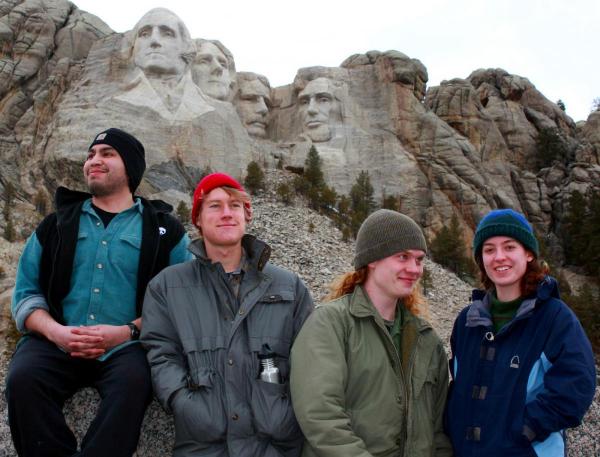Summer 2011
Editor’s Note
“For the many students who do interdisciplinary Plans, it’s the dialogue that’s important,” said theater professor Paul Nelsen at an open forum about the recent SymBiotic Art and Science conference. Paul explains that whether two disciplines collide or interact may depend as much upon the student as on the different fields involved, but it always creates an interesting dialogue. Ultimately it broadens our lives and has a humanistic impact beyond the studies themselves.
Interdisciplinary exploration is a well-practiced approach at Marlboro, as you can see from many of the Plans of Concentration listed in the commencement section of this issue of Potash Hill. Like all academic endeavors, that work never stops as we explore new and deeper connections between apparently separate perspectives. This issue celebrates Marlboro’s interdisciplinary tradition, whether it’s between philosophy and economics in Isaac Lawrence’s article on the Vermont Land Trust, or literature and international development in Rosario de Swanson’s piece on Guinean writers. It also explores new horizons in the SymBiotic Art and Science conference mentioned above and the Embodied Learning Symposium hosted here on campus.
As always, we welcome your comments. How has interdisciplinary study made an impact on your life and career, and what exciting new syntheses are out there to explore? You can find responses to the last issue in Letters.
—Philip Johansson, editor
Front cover: “La Mer,” a freehand paper cut on recycled paper by Paige E. Martin ’11, from her Plan exhibition titled “When Pictures Speak.” Photo by Jeff Woodward
Table of Contents
Restoring Kona Forests

by Robert Cabin ’89
Restoration ecology has been called the “acid test” of ecological sciences: If we really understand how ecosystems function, we should be able to put them back together again. Bob Cabin is rising to that challenge in the devastated dry forests of Hawaii.
I could see the charred remains of the ghost forest from the highway. One mile below me, the dead trees rose up from the land like giant skeletons. There were many reasons not to walk down there: the steep slope, the intense heat, the dense swath of neck-high African fountain grass I would have to fight my way through to reach the ruined trees. Even worse, I’d worked as a restoration ecologist in Hawaii long enough to visualize the devastation I was going to see when I got there. But a glimmer of hope for this ecological wreckage also compelled me to go, so I stepped off the highway and into a sea of dead grass, toward the barren lava flow and the burnt forest beyond.
The lowland, dry, leeward sides of all the main Hawaiian Islands were once covered by vast, magnificent forests teeming with strange and beautiful species found nowhere else on earth. Tens of thousands of brightly colored, fungi-eating snails slithered through the trees and inched their way along the dark underlying leaf litter. Vast flocks of giant flightless geese squawked across the forest understories; dozens of species of finch-like honeycreepers sipped nectar, gobbled insects and sought shelter from the heat and hungry eagles, hawks and owls.
The Hawaiians loved these forests and often chose to live in or near them. Due to the hot and dry climate, many of the trees grew extremely slowly and produced some of the hardest woods in the world, which the Hawaiians fashioned into buildings, tools, weapons and musical instruments. They also made exquisite, multicolored capes containing hundreds of thousands of bird feathers, and strung elaborate leis out of vines and sweet-smelling flowers. The first time I walked through a patch of native dry forest containing a grove of alahee trees in full bloom, I told my native Hawaiian colleague that the light fragrance of their delicate white flowers seemed to creep mysteriously in and out of my nostrils. He smiled and explained that the Hawaiian word alahee literally means “to move through the forest like an octopus.”
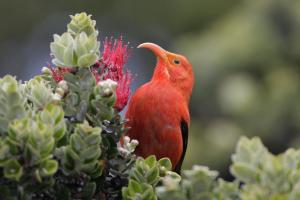 Today we can only imagine what these complex ecosystems looked like and guess at how they worked. Tragically, about 95 percent of Hawaii’s original dry forests have been destroyed, and many of their most ecologically important species are functionally, or actually, extinct. For example, most of the native birds and insects that once performed such critical services as flower pollination and seed scarification and dispersal are now gone. Many of the once dominant and culturally important canopy trees are also extinct or exist in only a few small populations of scattered and senescent individuals.
Today we can only imagine what these complex ecosystems looked like and guess at how they worked. Tragically, about 95 percent of Hawaii’s original dry forests have been destroyed, and many of their most ecologically important species are functionally, or actually, extinct. For example, most of the native birds and insects that once performed such critical services as flower pollination and seed scarification and dispersal are now gone. Many of the once dominant and culturally important canopy trees are also extinct or exist in only a few small populations of scattered and senescent individuals.
The demise of Hawaii’s dry forests began soon after the Polynesian discovery of these islands around 400 A.D. Like indigenous people throughout the tropics, the early Hawaiians cleared and burned the dry coastal forests and converted them into cultivated grasslands, agricultural plantations and thickly settled villages. Captain James Cook’s arrival in 1778 set in motion a chain of events that dramatically accelerated the scope and intensity of habitat destruction and species extinctions throughout the Hawaiian Islands. While the Polynesians had deliberately brought many new species to Hawaii in their double-hulled sailing canoes (and some stowaways such as the Polynesian rat, geckos, skinks and various weeds), their impact was trivial compared to the ecological bombs dropped by the Europeans. Thinking the islands deprived of some of God’s most useful and important species, Cook and his successors, with the best of intentions, set free cows, sheep, deer, goats, horses and pigs. Over time, foreigners from around the world unleashed a veritable Pandora’s box of more ecological wrecking machines, including two more species of rats, mongooses (in an infamously ill-advised attempt to control the rats), mosquitoes, ants and a diverse collection of noxious weeds. These included the African fountain grass that scratched my bare arms and legs as I struggled to reach the burnt forest.
During relatively rainy periods, when fountain grass greens up and is in full bloom, large swaths of the leeward side of the Big Island can look like a lush Midwestern prairie. But inevitably, the merciless kona (leeward) sunshine returns, and the rains disappear for months on end. The fountain grass dries to a sickly brown; then all it takes is somebody to park their hot car over a clump of grass for the whole region to burst into flame like a barn full of dry hay. In contrast to most Hawaiian species, fountain grass originated within a savanna ecosystem that regularly burned, and consequently has had thousands of years to evolve mechanisms to cope with and even exploit large-scale fires. I have watched fountain grass rise up from its ashes like a green phoenix after several seemingly devastating wildfires: Vigorous new shoots quickly appear within the old burned clumps, seeds germinate en masse and the emerging seedlings rapidly establish within the favorable post-fire environment of increased light and nutrients and decreased plant competition.
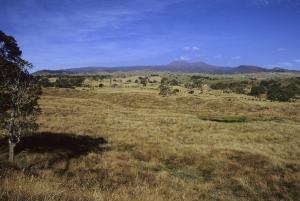 The net result of these fires is thus more fountain grass and less native dry forest. More grass means that during the next drought there will be even greater fuel loads, which in turn leads to more frequent and widespread fires. This growing cycle of alien grass and fire has proven to be the nail in the coffin for dry forests on the Big Island and throughout the tropics as a whole. The reason we don’t hear about campaigns to save tropical dry forests is because there are now virtually no such forests left to save. If we want at least some semblance of this ecosystem to exist in the future, we’ll have to deliberately and painstakingly design, plant, grow and care for them ourselves.
The net result of these fires is thus more fountain grass and less native dry forest. More grass means that during the next drought there will be even greater fuel loads, which in turn leads to more frequent and widespread fires. This growing cycle of alien grass and fire has proven to be the nail in the coffin for dry forests on the Big Island and throughout the tropics as a whole. The reason we don’t hear about campaigns to save tropical dry forests is because there are now virtually no such forests left to save. If we want at least some semblance of this ecosystem to exist in the future, we’ll have to deliberately and painstakingly design, plant, grow and care for them ourselves.
As I approached the dead trees, I was hot and frustrated that I had not even seen this forest before it burned. Yet in a bittersweet way I was glad that I had never been there, because even without any personal connection to this place, the sight of those wrecked trees was almost unbearably depressing. This had apparently been one of the best native dry forest remnants left within the entire state, but now we would never know which species had lived here, and we would never be able to collect seeds or cuttings from its gnarled old trees that were now on the very edge of extinction.
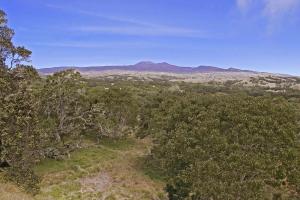 I looked back upslope at our tiny parcels of native trees straddling the highway. To preserve and restore these forest remnants, our Dryland Forest Working Group collectively spent thousands of hours installing fire breaks, killing fountain grass and exotic rodents, collecting seeds, and propagating and transplanting thousands of native plants. Local groups ranging from troubled Hawaiian teenagers to real estate agents had repeatedly donated their time and labor to help with these efforts. Hundreds of people within and beyond the Hawaiian Islands had come to see and study this ecosystem. My own scientific research program had progressed from documenting the demise of these forests to experimenting with promising techniques for restoring them at ever-larger spatial scales.
I looked back upslope at our tiny parcels of native trees straddling the highway. To preserve and restore these forest remnants, our Dryland Forest Working Group collectively spent thousands of hours installing fire breaks, killing fountain grass and exotic rodents, collecting seeds, and propagating and transplanting thousands of native plants. Local groups ranging from troubled Hawaiian teenagers to real estate agents had repeatedly donated their time and labor to help with these efforts. Hundreds of people within and beyond the Hawaiian Islands had come to see and study this ecosystem. My own scientific research program had progressed from documenting the demise of these forests to experimenting with promising techniques for restoring them at ever-larger spatial scales.
Looking at the fruits of our work from this distance, I felt a wave of optimism sweep over me, and for the first time truly believed that even this saddest of all the sad Hawaiian ecosystems could be saved. I turned around again and looked at the scorched trees. “We can grow another forest here,” I muttered. “We know what to do, and how to do it.” I stomped on a clump of resprouting fountain grass, slung on my pack and marched back up to the highway to get to work.
Robert Cabin is an associate professor of ecology and environmental science at Brevard College. This article is adapted from his book Intelligent Tinkering: Bridging the Gap Between Science and Practice, which will be published by Island Press this summer (ISBN: 9781597269643). You can read Bob’s views on environmental issues in his Huffington Post blog.
Phylogenetic Tree: The Evolutionary Legacy of Bob Engel
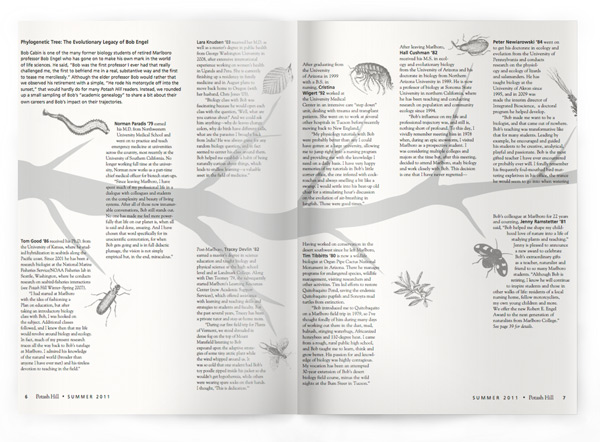
Bob Cabin is one of the many former biology students of retired Marlboro professor Bob Engel who has gone on to make his own mark in the world of life sciences. He said, “Bob was the first professor I ever had that really challenged me, the first to befriend me in a real, substantive way and the first to tease me mercilessly.” Although the elder professor Bob would rather that we observed his retirement with a simple, “He rode his motorcycle off into the sunset,” that would hardly do for many Potash Hill readers. Instead, we rounded up a small sampling of Bob’s “academic genealogy” to share a bit about their own careers and Bob’s impact on their trajectories.
Tom Good ’86 received his Ph.D. from the University of Kansas, where he studied hybridization in seabirds along the Pacific coast. Since 2001 he has been a research biologist at the National Marine Fisheries Service/NOAA Fisheries lab in Seattle, Washington, where he conducts research on seabird-fisheries interactions (see Potash Hill Winter–Spring 2007). “I had started at Marlboro with the idea of fashioning a Plan on education, but after taking an introductory biology class with Bob, I was hooked on the subject. Additional classes followed, and I knew then that my life would revolve around biology and ecology. In fact, much of my present research traces all the way back to Bob’s tutelage at Marlboro. I admired his knowledge of the natural world (broader than anyone I have ever met) and his tireless devotion to teaching in the field.”
After leaving Marlboro, Hall Cushman ’82 received his M.S. in ecology and evolutionary biology from the University of Arizona and his doctorate in biology from Northern Arizona University in 1989. He is now a professor of biology at Sonoma State University in northern California, where he has been teaching and conducting research on population and community ecology since 1994. “Bob’s influence on my life and professional trajectory was, and still is, nothing short of profound. To this day, I vividly remember meeting him in 1978 when, during an epic snowstorm, I visited Marlboro as a prospective student. I was considering multiple colleges and majors at the time but, after this meeting, decided to attend Marlboro, study biology and work closely with Bob. This decision is one that I have never regretted—I am still devoted to Marlboro, biology, teaching and research.”
Post-Marlboro, Tracey Devlin ’82 earned a master’s degree in science education and taught biology and physical science at the high school level and at Landmark College. Along with Dan Toomey ’79, she subsequently started Marlboro’s Learning Resources Center (now Academic Support Services), which offered assistance with learning and teaching skills and strategies to students and faculty. For the past several years, Tracey has been a private tutor and stay-at-home mom. “During our first field trip for Plants of Vermont, we stood shrouded in dense fog on the top of Mount Mansfield listening to Bob expound upon the adaptive strategies of some tiny arctic plant while the wind whipped around us. It was so cold that one student had Bob’s toy poodle zipped inside his jacket so she wouldn’t get hypothermia, while others were wearing spare socks on their hands. I thought, ‘This is dedication.’”
Norman Paradis ’79 earned his M.D. from Northwestern University Medical School and went on to practice and teach emergency medicine at universities across the country, most recently at the University of Southern California. No longer working full time at the university, Norman now works as a part-time chief medical officer for biotech start-ups. “Since leaving Marlboro, I have spent much of my professional life in a dialogue with colleagues and students on the complexity and beauty of living systems. After all of those now innumerable conversations, Bob still stands out. No one has made me feel more powerfully that life on our planet is, when all is said and done, amazing. And I have chosen that word specifically for its unscientific connotation, for when Bob gets going and is in full didactic plumage, the vision is not simply empirical but, in the end, miraculous.”
Lara Knudsen ’03 received her M.D. as well as a master’s degree in public health from George Washington University in 2008, after extensive international experience working on women’s health in Uganda and Peru. She is currently finishing up a residency in family medicine and in August plans to move back home to Oregon (with her husband, Chris Jones ’05). “Biology class with Bob was fascinating because he would open each class with the question, ‘Well, what are you curious about?’ And we could ask him anything—why do leaves change colors, why do birds have different calls, what are the parasites I brought back from India? He was always game for any random biology question, and in fact seemed to center his class around them. Bob helped me establish a habit of being naturally curious about things, which leads to endless learning—a valuable asset in the field of medicine.”
Having worked on conservation in the desert southwest since he left Marlboro, Tim Tibbitts ’80 is now a wildlife biologist at Organ Pipe Cactus National Monument in Arizona. There he manages programs for endangered species, wildlife management, visiting researchers and other activities. Tim led efforts to restore Quitobaquito Pond, saving the endemic Quitobaquito pupfish and Sonoyta mud turtles from extinction. “Bob introduced me to Quitobaquito on a Marlboro field trip in 1979, so I’ve thought fondly of him during many days of working out there in the dust, mud, bulrush, stinging waterbugs, Africanized honeybees and 110-degree heat. I came from a rough, rural public high school, and Bob taught me to learn, think and grow better. His passion for and knowledge of biology was highly contagious. My vocation has been an attempted 30-year extension of Bob’s desert biology field course, minus the wild nights at the Bum Steer in Tucson.”
After graduating from the University of Arizona in 1999 with a B.S. in nursing, Cristina Wigert ’92 worked at the University Medical Center in an intensive care “step down” unit, dealing with trauma and transplant patients. She went on to work at several other hospitals in Tucson before recently moving back to New England. “My physiology tutorials with Bob were probably better than any I could have gotten at a large university, allowing me to jump right into a nursing program and providing me with the knowledge I need on a daily basis. I have very happy memories of my tutorials in Bob’s little corner office, the one infested with cockroaches and always smelling a bit like a swamp. I would settle into his beat-up old chair for a stimulating hour’s discussion on the evolution of air-breathing in lungfish. Those were good times.”
Peter Newiarowski ’84 went on to get his doctorate in ecology and evolution from the University of Pennsylvania and conducts research on the physiology and ecology of lizards and salamanders. He has taught biology at the University of Akron since 1995, and in 2009 was made the interim director of Integrated Bioscience, a doctoral program he helped develop. “Bob made me want to be a biologist, and that came out of nowhere. Bob’s teaching was transformative like that for many students. Leading by example, he encouraged and guided his students to be creative, analytical, playful and passionate. Bob is the most gifted teacher I have ever encountered or probably ever will. I fondly remember his frequently foul-mouthed bird muttering expletives in his office, the trance he would seem to go into when watering plants in the greenhouse and his insane and irrational love of the VW microbus.”
Bob’s colleague at Marlboro for 22 years and counting, Jenny Ramstetter ’81 said, “Bob helped me shape my childhood love of nature into a life of studying plants and teaching.” Jenny is pleased to announce a new award to celebrate Bob’s extraordinary gifts as a teacher, naturalist and friend to so many Marlboro students. “Although Bob is retiring, I know he will continue to inspire students and those in other walks of life: residents of a local nursing home, fellow motorcyclists, my own young children and more. We offer the new Robert E. Engel Award to the next generation of naturalists from Marlboro College.”
How to convert this country into a paradise
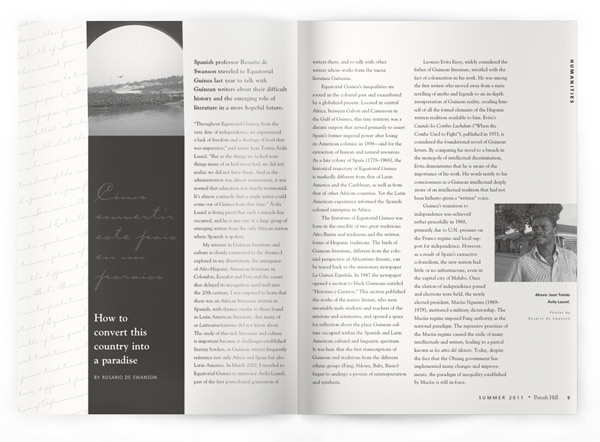
Cómo convertir este país en un paraíso
by Rosario de Swanson
Spanish professor Rosario de Swanson traveled to Equatorial Guinea last year to talk with Guinean writers about their difficult history and the emerging role of literature in a more hopeful future.
“Throughout Equatorial Guinea, from the very date of independence, we experienced a lack of freedom and a shortage of food that was impressive,” said writer Juan Tomás Ávila Laurel. “But as the things we lacked were things many of us had never had, we did not realize we did not have them. And as the administration was almost nonexistent, it was normal that education was merely testimonial. It’s almost a miracle that a single writer could come out of Guinea from that time.” Ávila Laurel is living proof that such a miracle has occurred, and he is just one of a large group of emerging writers from the only African nation where Spanish is spoken.
My interest in Guinean literature and culture is closely connected to the themes I explored in my dissertation: the emergence of Afro-Hispanic American literature in Colombia, Ecuador and Peru and the causes that delayed its recognition until well into the 20th century. I was surprised to learn that there was an African literature written in Spanish, with themes similar to those found in Latin American literature, that many of us Latinoamericanistas did not know about. The study of this rich literature and culture is important because it challenges established literary borders, as Guinean writers frequently reference not only Africa and Spain but also Latin America. In March 2010, I traveled to Equatorial Guinea to interview Ávila Laurel, part of the first postcolonial generation of writers there, and to talk with other writers whose works form the nueva literatura Guineana.
Equatorial Guinea’s inequalities are rooted in the colonial past and exacerbated by a globalized present. Located in central Africa, between Gabon and Cameroon in the Gulf of Guinea, this tiny territory was a distant outpost that served primarily to assert Spain’s former imperial power after losing its American colonies in 1898—and for the extraction of human and natural resources. As a late colony of Spain (1778–1968), the historical trajectory of Equatorial Guinea is markedly different from that of Latin America and the Caribbean, as well as from that of other African countries. Yet the Latin American experience informed the Spanish colonial enterprise in Africa.
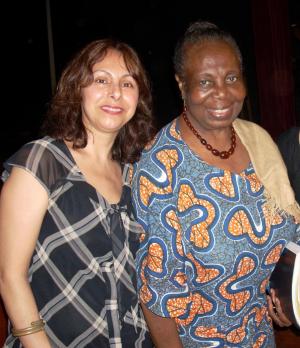 The literature of Equatorial Guinea was born in the crucible of two great traditions: Afro-Bantu oral traditions and the written forms of Hispanic traditions. The birth of Guinean literature, different from the colonial perspective of Africanismo literario, can be traced back to the missionary newspaper La Guinea Española. In 1947 the newspaper opened a section to black Guineans entitled “Historias y Cuentos.” This section published the works of the native literati, who were invariably male students and teachers of the missions and seminaries, and opened a space for reflection about the place Guinean culture occupied within the Spanish and Latin American cultural and linguistic spectrum. It was here that the first transcriptions of Guinean oral traditions from the different ethnic groups (Fang, Ndowe, Bubi, Bissio) began to undergo a process of reinterpretation and synthesis.
The literature of Equatorial Guinea was born in the crucible of two great traditions: Afro-Bantu oral traditions and the written forms of Hispanic traditions. The birth of Guinean literature, different from the colonial perspective of Africanismo literario, can be traced back to the missionary newspaper La Guinea Española. In 1947 the newspaper opened a section to black Guineans entitled “Historias y Cuentos.” This section published the works of the native literati, who were invariably male students and teachers of the missions and seminaries, and opened a space for reflection about the place Guinean culture occupied within the Spanish and Latin American cultural and linguistic spectrum. It was here that the first transcriptions of Guinean oral traditions from the different ethnic groups (Fang, Ndowe, Bubi, Bissio) began to undergo a process of reinterpretation and synthesis.
Leoncio Evita Enoy, widely considered the father of Guinean literature, wrestled with the fact of colonization in his work. He was among the first writers who moved away from a mere retelling of myths and legends to an in-depth interpretation of Guinean reality, availing himself of all the formal elements of the Hispanic written tradition available to him. Evita’s Cuando los Combes Luchaban (“When the Combe Used to Fight”), published in 1953, is considered the foundational novel of Guinean letters. By comparing his novel to a breach in the monopoly of intellectual discrimination, Evita demonstrates that he is aware of the importance of his work. His words testify to his consciousness as a Guinean intellectual deeply aware of an intellectual tradition that had not been hitherto given a “written” voice.
Guinea’s transition to independence was achieved rather peacefully in 1968, primarily due to U.N. pressure on the Franco regime and local support for independence. However, as a result of Spain’s extractive colonialism, the new nation had little or no infrastructure, even in the capital city of Malabo. Once the elation of independence passed and elections were held, the newly elected president, Macías Nguema (1969–1979), instituted a military dictatorship. The Macías regime imposed Fang authority as the national paradigm. The repressive practices of the Macías regime caused the exile of many intellectuals and writers, leading to a period known as los años del silencio. Today, despite the fact that the Obiang government has implemented many changes and improvements, the paradigm of inequality established by Macías is still in force.
When I asked Juan Tomás Ávila Laurel about recent reforms, he responded, “The most important change is to see the dimming of repression. Now there are no beatings or arbitrary arrests in public. Clearly, if the previous regime had persisted I would not be a writer. Now people in the country can accuse the president of wrongdoing and live. In the Macías regime, a small criticism spelled a mortal threat.”
Today, Equatorial Guinea’s problems and inequalities have become aggravated by the extreme exploitation of the country’s natural resources. The discovery of oil in the ’90s marked the entry of Guinea into the world markets as a powerful oil producer, but this economic boom has not led to improvements for many of its citizens. Instead, it has installed a brand of capitalism that seeks to turn Guineans into consumers of Western goods. Most Guineans who can afford it drink water from imported plastic bottles; however, since there are no provisions for proper disposal, these symbols of Western modernity litter the landscape. Corruption is rampant, and life for most Guineans is lived under feudal conditions: Equatorial Guinea stands out as the only African country where the economic growth rate is among the highest in the world while the majority of the population lives in poverty.
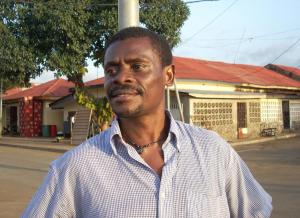 Against this backdrop, the writers, artists and intellectuals of the various ethnicities have become a powerful force for integration, resistance and consciousness-raising through their literature and works of art. In his essays, Ávila Laurel examines the roots of Guinean inequalities, its history and politics, and the contradiction between state modernizing initiatives and life as it is lived by most Guineans. He also offers a penetrating critique of Guinea’s culture, traditions and attitudes, rooted in Guinea’s tragic and rich history, where he also finds the promise of Guinea’s future.
Against this backdrop, the writers, artists and intellectuals of the various ethnicities have become a powerful force for integration, resistance and consciousness-raising through their literature and works of art. In his essays, Ávila Laurel examines the roots of Guinean inequalities, its history and politics, and the contradiction between state modernizing initiatives and life as it is lived by most Guineans. He also offers a penetrating critique of Guinea’s culture, traditions and attitudes, rooted in Guinea’s tragic and rich history, where he also finds the promise of Guinea’s future.
In our interview he said, “The Guinean intellectual should denounce certain things that happen in our society, not because he is an intellectual but because there are some people who have the possibility of having their opinions disseminated and heard. Since this is a multiethnic nation, our cultures should reconcile or unify us. Cultural manifestations should be the expression of our Guinean-ness, with culture understood as its crystallization.”
Ávila Laurel explores the future of development in Equatorial Guinea in many of his essays, such as “Cómo convertir este país en un paraíso.” In our interview he said he wanted Guinea to enjoy a kind of development that takes into account ethnic diversity, the environment and the material and spiritual needs of the people. Although the term “barbarism” was once associated with indigenous peoples, and served as justification for the colonial enterprise, Ávila Laurel criticizes the barbarism of the despotic model adopted by Macías and his successors. “If someone says they are developed but they lack human rights, they are not,” he said. “If I dare to associate barbarism with Macías it is to relate his regime to Western culture. Macías was more the product of Western civilization than of African culture.”
The essays of Juan Tomás Ávila Laurel provide a contemporary insight on debates that dominated Latin American intellectual and political thought at the end of the 19th and early in the 20th century but are now part of Guinea’s intellectual discourse about the future. In the end, Ávila Laurel shares the same distrust of the economic benefits of “civilization” as his predecessor Leoncio Evita Enoy, who in his novel referred to it as a “sickness.” “Some believe they are superior to others because they come from a society that has learned to influence nature,” said Ávila Laurel. “Usually the so-called civilized society is the leader in the domain of nature. It is clear that those who have managed to dominate nature have abused this privilege. Guinea’s struggle is to find its place in the world without believing that it is a sin not to have taken the same steps as other countries on other continents.”
Rosario de Swanson teaches Spanish and Latin American literature at Marlboro. Her article “Autoenografía, espacio, identidad y resistencia en la narrativa fundacional de Guinea Ecuatorial: Cuando los combes luchaban (1953) de Leoncio Evita Enoy” is to be published in Revista Iberoamericana in 2011. Her interview with Juan Tomás Ávila Laurel, titled “Si alguien dice que está desarrollado y no goza de los derechos humanos, no lo está,” will appear in Hispanic Journal.
Cold War Femininity
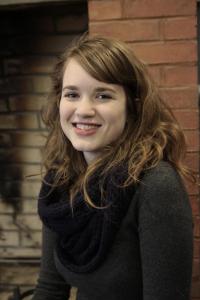 Not unlike postcolonial African writers grappling with their national identity, acclaimed author Flannery O’Connor struggled with issues of femininity in the postwar era. Although most scholars have downplayed it, Elizabeth Ferrell ’11 chose to focus on this struggle in her Plan of Concentration. “Despite O’Connor’s persistent refusal to accept that her female characters experience a plight beyond religion, it is still apparent that she had a unique stance as a critically acclaimed female writer in the 1940s,” said Elizabeth. In studying the multifaceted female characters in O’Connor’s short fiction, Elizabeth concluded that their complexity extends to gender dynamics as well as religious themes. “Much like these characters can’t be contained within the traditional submissive female role, they also refuse to be pigeonholed into being plot devices for religious purposes.”
Not unlike postcolonial African writers grappling with their national identity, acclaimed author Flannery O’Connor struggled with issues of femininity in the postwar era. Although most scholars have downplayed it, Elizabeth Ferrell ’11 chose to focus on this struggle in her Plan of Concentration. “Despite O’Connor’s persistent refusal to accept that her female characters experience a plight beyond religion, it is still apparent that she had a unique stance as a critically acclaimed female writer in the 1940s,” said Elizabeth. In studying the multifaceted female characters in O’Connor’s short fiction, Elizabeth concluded that their complexity extends to gender dynamics as well as religious themes. “Much like these characters can’t be contained within the traditional submissive female role, they also refuse to be pigeonholed into being plot devices for religious purposes.”
Perpetual Farming
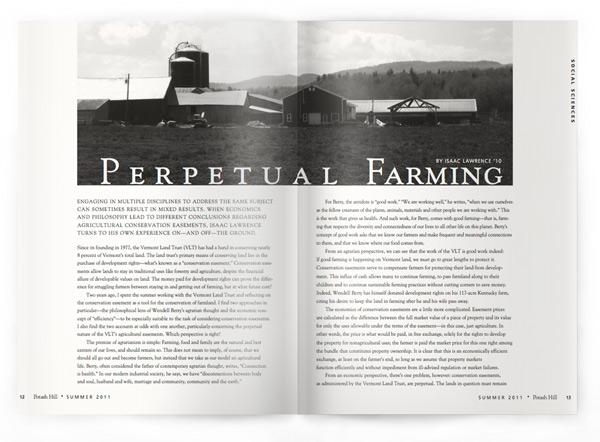
by Isaac Lawrence ’10
Engaging in multiple disciplines to address the same subject can sometimes result in mixed results. When economics and philosophy lead to different conclusions regarding agricultural conservation easements, Isaac Lawrence turns to his own experience on—and off—the ground.
Since its founding in 1977, the Vermont Land Trust (VLT) has had a hand in conserving nearly 8 percent of Vermont’s total land. The land trust’s primary means of conserving land lies in the purchase of development rights—what’s known as a “conservation easement.” Conservation easements allow lands to stay in traditional uses like forestry and agriculture, despite the financial allure of developable values on land. The money paid for development rights can prove the difference for struggling farmers between staying in and getting out of farming, but at what future cost?
Two years ago, I spent the summer working with the Vermont Land Trust and reflecting on the conservation easement as a tool for the conservation of farmland. I find two approaches in particular—the philosophical lens of Wendell Berry’s agrarian thought and the economic concept of “efficiency”—to be especially suitable to the task of considering conservation easements. I also find the two accounts at odds with one another, particularly concerning the perpetual nature of the VLT’s agricultural easements. Which perspective is right?
The premise of agrarianism is simple: Farming, food and family are the natural and best centers of our lives, and should remain so. This does not mean to imply, of course, that we should all go out and become farmers, but instead that we take as our model an agricultural life. Berry, often considered the father of contemporary agrarian thought, writes, “Connection is health.” In our modern industrial society, he says, we have “disconnections between body and soul, husband and wife, marriage and community, community and the earth.”
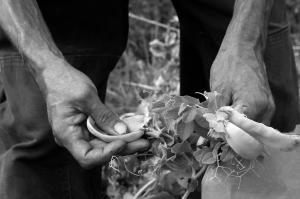 For Berry, the antidote is “good work.” “We are working well,” he writes, “when we use ourselves as the fellow creatures of the plants, animals, materials and other people we are working with.” This is the work that gives us health. And such work, for Berry, comes with good farming—that is, farming that respects the diversity and connectedness of our lives to all other life on this planet. Berry’s concept of good work asks that we know our farmers and make frequent and meaningful connections to them, and that we know where our food comes from.
For Berry, the antidote is “good work.” “We are working well,” he writes, “when we use ourselves as the fellow creatures of the plants, animals, materials and other people we are working with.” This is the work that gives us health. And such work, for Berry, comes with good farming—that is, farming that respects the diversity and connectedness of our lives to all other life on this planet. Berry’s concept of good work asks that we know our farmers and make frequent and meaningful connections to them, and that we know where our food comes from.
From an agrarian perspective, we can see that the work of the VLT is good work indeed: If good farming is happening on Vermont land, we must go to great lengths to protect it. Conservation easements serve to compensate farmers for protecting their land from development. This influx of cash allows many to continue farming, to pass farmland along to their children and to continue sustainable farming practices without cutting corners to save money. Indeed, Wendell Berry has himself donated development rights on his 117-acre Kentucky farm, citing his desire to keep the land in farming after he and his wife pass away.
The economics of conservation easements are a little more complicated. Easement prices are calculated as the difference between the full market value of a piece of property and its value for only the uses allowable under the terms of the easement—in this case, just agriculture. In other words, the price is what would be paid, in free exchange, solely for the rights to develop the property for nonagricultural uses; the farmer is paid the market price for this one right among the bundle that constitutes property ownership. It is clear that this is an economically efficient exchange, at least on the farmer’s end, so long as we assume that property markets function efficiently and without impediment from ill-advised regulation or market failures.
From an economic perspective, there’s one problem, however: conservation easements, as administered by the Vermont Land Trust, are perpetual. The lands in question must remain in farming forever. What if consumer preferences change in the future, and farming is no longer the most efficient use of the land? We can already assert that farming in the northeastern United States is a difficult, often inefficient, process. Even now, our desire to save farmland must be chalked up to cultural identity, or to aesthetics, or to some moral virtue associated with farming. What if, in the future, our willingness to pay for these things diminishes relative to some other use of the land? “Better” uses of conserved lands may well arise as preferences change, and there is a likelihood, quite high over a long time frame, that these uses will be more economically efficient. By limiting the opportunity of future generations to enact different sets of values on Vermont land, the VLT takes away what may be a very important right of future generations.
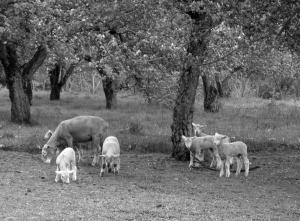 The difference between agrarian and economic perspectives on conservation easements hinges on this very issue. Agrarian thought suggests that there are some lasting values in natural systems, in what Berry calls the “Great Economy.” If these values exist outside of humanity, then they will continue to exist into the future, regardless of changes to humanity. In this, the perpetual nature of conservation easements is endorsed.
The difference between agrarian and economic perspectives on conservation easements hinges on this very issue. Agrarian thought suggests that there are some lasting values in natural systems, in what Berry calls the “Great Economy.” If these values exist outside of humanity, then they will continue to exist into the future, regardless of changes to humanity. In this, the perpetual nature of conservation easements is endorsed.
Economics, on the other hand, is concerned only with human wants. What is good, in terms of maximizing utility, is what is good for humanity. The good life is one of maximal utility for humans. As such, small-scale farming is only useful as long as we take it be so—as long as there are not uses of our scarce resources that we find more fruitful. For example, if we find that we would rather spend our time making art, or building cities, than farming, we may find that we would prefer to mechanize farm work, to disengage from the sources of our food and the like.
My experience on the ground with farmers working with the Vermont Land Trust has some bearing here. On one particular day, all three of the farmers we talked to recalled some initial hesitancy in the easement process. Giving up their rights to do what they will with the land ran counter to what I took to be a real premium on autonomy. The easement had been something of a compromise for each of them, and each had different ends in mind. What was shared was a deep respect for the land and for farming as a lifestyle. None of the farmers I spoke with wanted to see their farm get cut up into lots for houses, or sold for condominium development. They all expressed concern for the environmental health of their property. The conservation easement seemed a great conciliatory mechanism, and the farmers struck me as admirable for their hard work, for their commitment to good land use and for their practicality.
When we arrived at the third farm, we first went to take pictures that we would need to pitch the Project to the Vermont Housing and Conservation Board for funding. My supervisor thought it would be best to get a shot from above, and the crow’s nest at the top of the silo seemed the best place. He climbed the narrow ladder on the outside of the structure with what I later learned was characteristic energy and athleticism. Coming down, he assured me that I too needed to climb up, for the view. Afraid, I started up. Just as the drop below became utterly terrifying, the ladder acquired a cage, and only because of this was I able to get to the top. The view was, as my boss had suggested, spectacular. It was a perfect early July, Addison County day, and my view extended across miles of picturesque rolling farmland, with Lake Champlain and the Adirondacks in the distance. As a lifetime Vermonter, a descendent of Vermont dairy farmers on both sides, and as a longtime lover of the outdoors, I found the sight stirring.
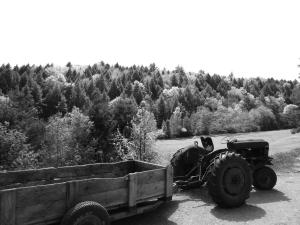 Not surprisingly, my past predisposes me to some sympathy for Berry’s account and for perpetual conservation easements on farms—future generations’ potentially different wants be damned. At the same time, I also have great sympathy for the economic account: It suggests that what matters most is the aggregate welfare of all the people affected by a particular decision, rather than considering one person’s values more important than another’s. Which perspective is right?
Not surprisingly, my past predisposes me to some sympathy for Berry’s account and for perpetual conservation easements on farms—future generations’ potentially different wants be damned. At the same time, I also have great sympathy for the economic account: It suggests that what matters most is the aggregate welfare of all the people affected by a particular decision, rather than considering one person’s values more important than another’s. Which perspective is right?
In this case I can confidently say that preserving farmland for small, conscientious farmers is likely to be a good thing long into the future. My meetings with farmers left me with the feeling that, for a multitude of reasons, conservation easements were good for farmers and, for reasons like those that Berry articulated, for Vermont and Vermonters in general. Only my experience was capable of differentiating the two analytical frameworks I thought equally relevant to VLT’s work. This experience instills in me a powerful belief that the work of small, responsible farmers is valuable and, therefore, worth preserving.
Isaac Lawrence graduated in 2010 with a Plan in economics and philosophy, focusing on environmental management. He is now doing regional planning as an AmeriCorps VISTA volunteer in Montpelier, Vermont, and will begin a master’s program in urban and regional planning in the fall.
Guitar Economy
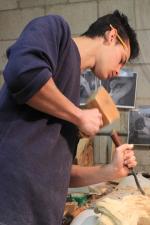 While agrarian ideals conserve rural landscapes, “craft” ideals offer alternatives to struggling urban communities. John Whelan ’11 says, “The creative economy is a model for economic development applicable to de-industrialized communities, communities once reliant on older industrial structures such as the mills in New England.” John’s Plan explores the role of craft production, specifically guitar making, in the creative economy of southern Vermont, and compares the values of local luthiers to those of veteran producers like Gibson, Fender and Taylor. “Those large-scale producers aim to preserve a reputation that embraces some craft ideals, and also play an important role in the creative economy,” John says. What they typically lack, which he finds among local instrument makers, is a high level of community engagement crucial to a successful creative economy model. Go to our website to see a video of John describing his Plan work .
While agrarian ideals conserve rural landscapes, “craft” ideals offer alternatives to struggling urban communities. John Whelan ’11 says, “The creative economy is a model for economic development applicable to de-industrialized communities, communities once reliant on older industrial structures such as the mills in New England.” John’s Plan explores the role of craft production, specifically guitar making, in the creative economy of southern Vermont, and compares the values of local luthiers to those of veteran producers like Gibson, Fender and Taylor. “Those large-scale producers aim to preserve a reputation that embraces some craft ideals, and also play an important role in the creative economy,” John says. What they typically lack, which he finds among local instrument makers, is a high level of community engagement crucial to a successful creative economy model. Go to our website to see a video of John describing his Plan work .
Wandering into Prose
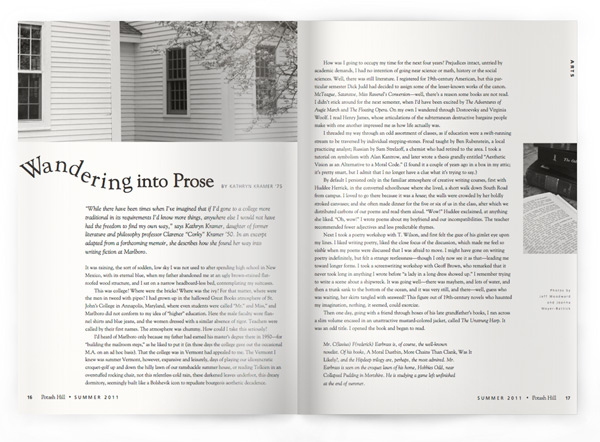
by Kathryn Kramer ‘75
“While there have been times when I’ve imagined that if I’d gone to a college more traditional in its requirements I’d know more things, anywhere else I would not have had the freedom to find my own way,” says Kathryn Kramer, daughter of former literature and philosophy professor Clarence “Corky” Kramer ’50. In an excerpt adapted from a forthcoming memoir, she describes how she found her way into writing fiction at Marlboro.
It was raining, the sort of sodden, low sky I was not used to after spending high school in New Mexico, with its eternal blue, when my father abandoned me at an ugly brown-stained flat-roofed wood structure, and I sat on a narrow headboard-less bed, contemplating my suitcases.
This was college? Where were the bricks? Where was the ivy? For that matter, where were the men in tweed with pipes? I had grown up in the hallowed Great Books atmosphere of St. John’s College in Annapolis, Maryland, where even students were called “Mr.” and Miss,” and Marlboro did not conform to my idea of “higher” education. Here the male faculty wore flannel shirts and blue jeans, and the women dressed with a similar absence of rigor. Teachers were called by their first names. The atmosphere was chummy. How could I take this seriously?
 I’d heard of Marlboro only because my father had earned his master’s degree there in 1950—for “building the mailroom steps,” as he liked to put it (in those days the college gave out the occasional M.A. on an ad hoc basis). That the college was in Vermont had appealed to me. The Vermont I knew was summer Vermont, however, expansive and leisurely, days of playing our idiosyncratic croquet-golf up and down the hilly lawn of our ramshackle summer house, or reading Tolkien in an overstuffed rocking chair, not this relentless cold rain, these darkened leaves underfoot, this dreary dormitory, seemingly built like a Bolshevik icon to repudiate bourgeois aesthetic decadence.
I’d heard of Marlboro only because my father had earned his master’s degree there in 1950—for “building the mailroom steps,” as he liked to put it (in those days the college gave out the occasional M.A. on an ad hoc basis). That the college was in Vermont had appealed to me. The Vermont I knew was summer Vermont, however, expansive and leisurely, days of playing our idiosyncratic croquet-golf up and down the hilly lawn of our ramshackle summer house, or reading Tolkien in an overstuffed rocking chair, not this relentless cold rain, these darkened leaves underfoot, this dreary dormitory, seemingly built like a Bolshevik icon to repudiate bourgeois aesthetic decadence.
How was I going to occupy my time for the next four years? Prejudices intact, untried by academic demands, I had no intention of going near science or math, history or the social sciences. Well, there was still literature. I registered for 19th-century American, but this particular semester Dick Judd had decided to assign some of the lesser-known works of the canon. McTeague, Satanstoe, Miss Ravenel’s Conversion—well, there’s a reason some books are not read. I didn’t stick around for the next semester, when I’d have been excited by The Adventures of Augie March and The Floating Opera. On my own I wandered through Dostoevsky and Virginia Woolf. I read Henry James, whose articulations of the subterranean destructive bargains people make with one another impressed me as how life actually was.
I threaded my way through an odd assortment of classes, as if education were a swift-running stream to be traversed by individual stepping-stones. Freud taught by Ben Rubenstein, a local practicing analyst; Russian by Sam Strelzoff, a chemist who had retired to the area. I took a tutorial on symbolism with Alan Kantrow, and later wrote a thesis grandly entitled “Aesthetic Vision as an Alternative to a Moral Code.” (I found it a couple of years ago in a box in my attic; it’s pretty smart, but I admit that I no longer have a clue what it’s trying to say.)
By default I persisted only in the familiar atmosphere of creative writing courses, first with Huddee Herrick, in the converted schoolhouse where she lived, a short walk down South Road from campus. I loved to go there because it was a house; the walls were crowded by her boldly stroked canvases; and she often made dinner for the five or six of us in the class, after which we distributed carbons of our poems and read them aloud. “Wow!” Huddee exclaimed, at anything she liked. “Oh, wow!” I wrote poems about my boyfriend and our incompatibilities. The teacher recommended fewer adjectives and less predictable rhymes.
Next I took a poetry workshop with T. Wilson, and first felt the gaze of his gimlet eye upon my lines. I liked writing poetry, liked the close focus of the discussion, which made me feel so visible when my poems were discussed that I was afraid to move. I might have gone on writing poetry indefinitely, but felt a strange restlessness—though I only now see it as that—leading me toward longer forms. I took a screenwriting workshop with Geoff Brown, who remarked that it never took long in anything I wrote before “a lady in a long dress showed up.” I remember trying to write a scene about a shipwreck. It was going well—there was mayhem, and lots of water, and then a trunk sank to the bottom of the ocean, and it was very still, and there—well, guess who was waiting, her skirts tangled with seaweed? This figure out of 19th-century novels who haunted my imagination, nothing, it seemed, could exorcize.
 Then one day, going with a friend through boxes of his late grandfather’s books, I ran across a slim volume encased in an unattractive mustard-colored jacket, called The Unstrung Harp. It was an odd title. I opened the book and began to read.
Then one day, going with a friend through boxes of his late grandfather’s books, I ran across a slim volume encased in an unattractive mustard-colored jacket, called The Unstrung Harp. It was an odd title. I opened the book and began to read.
Mr. C(lavius) F(rederick) Earbrass is, of course, the well-known novelist. Of his books, A Moral Dustbin, More Chains Than Clank, Was It Likely?, and the Hipdeep trilogy are, perhaps, the most admired. Mr. Earbrass is seen on the croquet lawn of his home, Hobbies Odd, near Collapsed Pudding in Mortshire. He is studying a game left unfinished at the end of summer.
A man with a horizontal football-shaped head and bushy mustaches peers with bafflement at the world. Mr. Earbrass is a writer, and his inveterate reluctance about everything, his perplexed participation in a world that misunderstands—this I recognized too. A writer’s life. I’d never read a description of one before.
Mr. Earbrass has rashly been skimming through the early chapters, which he has not looked at for months, and now sees TUH for what it is. Dreadful, dreadful, DREADFUL. He must be mad to go on enduring the unexquisite agony of writing when it all turns out drivel. Mad. Why didn’t he become a spy? How does one become one? He will burn the MS. Why is there no fire? Why aren’t there the makings of one? How did he get in the unused room on the third floor?
On I read: amazed, entertained, exhilarated. Accompanied. An afternoon not long after this I was taking a walk when a voice began to speak. I stopped walking and studied a stone wall in order better to listen to what was going on, seemingly distinct from me, in my mind.
“Edward was languishing next to the grape arbor,” I heard, “when suddenly it dawned on him; he could just as well think she’d died (though for his Lucia to do something so distinct!)—well, she had wilted. Certainly he should have known when she laughed at his ideas about islands….”
Lines of poems had used to arrive like that, but they had always been about me. Poetry I had used as a cri de coeur, a snapshot, an affirmation of self, but this was different. It felt different. I felt different, writing it. It was about someone else.
Inspired by the author of The Unstrung Harp, Edward Gorey, I had begun to discover a way out of anachronism. At the time I would no more have permitted an automobile or Saran Wrap into my prose than I would have gone streaking through the dining hall (an event so common that sometimes people no longer even looked up from their lunch when naked persons went screeching past the tables). I could use words like “asylum” or “embonpoint” and inhabit the world they constituted—just not quite.
The Mourning Dove (the decorous title of the novel I wrote for my senior Plan) owed a substantial debt not only to Edward Gorey, but to Henry James and Virginia Woolf. A Lambert Strether–like character, my poor protagonist deserved to be deceived by the woman he loved because he didn’t get it. He was the dupe. He had pulled the wool over his own eyes, so why shouldn’t others conspire with him against himself? This I evidently thought to be just. It would take me a long time to locate the source of my fascination with this archetypally dimwitted romantic—a complicated journey that would lead me back through the literature of my childhood—but I was experiencing the heady sense of participating for the first time in an ongoing conversation that really mattered to me.
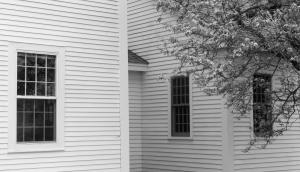 By now I lived for the hour each week when I sat with T. in his office in Dalrymple, and he questioned me about the chapters I’d given him. Would X really do that? Why is Y so unkind to Z? Why this word instead of that? Why the scene in which poor Edward stands by the rhododendrons here and not later? I’d made these things up, but someone else felt proprietary about them. To write thinking of one thing only to discover that I’d made another, which I could then revise and adjust, the better to approximate…it—I could have sat from dawn till dusk listening to T. talk about my manuscript.
By now I lived for the hour each week when I sat with T. in his office in Dalrymple, and he questioned me about the chapters I’d given him. Would X really do that? Why is Y so unkind to Z? Why this word instead of that? Why the scene in which poor Edward stands by the rhododendrons here and not later? I’d made these things up, but someone else felt proprietary about them. To write thinking of one thing only to discover that I’d made another, which I could then revise and adjust, the better to approximate…it—I could have sat from dawn till dusk listening to T. talk about my manuscript.
I’d grown up in the religion that held that the Great Thoughts had been propounded, and it was up to us latecomers to find out about them. We were to have faith in the existence of truth while recognizing that we ourselves most likely would never attain it. All through my school years I’d been obsessed with getting right answers—fearing to get it wrong while not believing that I could get it right. Now I was discovering a way out of this paradox. Make things up. It can’t be wrong if it’s invented. It’s not real—it’s fiction.
Except, of course, it is real, in a sneaky, roundabout way that mere idea can never master. If you can get it right, fictionally right—and this is the lifelong mysterious work of it—you do speak the truth, in words from which it cannot be extricated. Unlike with poetry, the work, not I, was the subject under discussion. For the first time, I felt like a writer.
Kathryn Kramer teaches creative writing and literature at Middlebury College and is the author of several books, most recently Sweet Water. This excerpt is adapted from the forthcoming Missing History: The Covert Education of a Child of the Great Books.
Movement and Media Violence
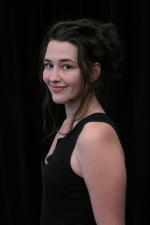 Marlboro students often wander more than one academic path to find their way, as demonstrated by Heather Reed ’11, who finds surprising synergies between film and dance. “I want to change how people think about movement, and encourage the expansion of what has been called an ever-shrinking human movement vocabulary,” said Heather. Her interdisciplinary Plan paper looks at how violent media action affects movement, and how the growing glut of violent media has long-term physiological impacts. “Violent media and media saturation cause symptoms ranging from depression to obesity to increased aggression. I’m using tenets of dance movement therapy to help understand these symptoms and discover what can be done to create a better-moving, better-feeling society to combat the ill effects of violent media exposure.”
Marlboro students often wander more than one academic path to find their way, as demonstrated by Heather Reed ’11, who finds surprising synergies between film and dance. “I want to change how people think about movement, and encourage the expansion of what has been called an ever-shrinking human movement vocabulary,” said Heather. Her interdisciplinary Plan paper looks at how violent media action affects movement, and how the growing glut of violent media has long-term physiological impacts. “Violent media and media saturation cause symptoms ranging from depression to obesity to increased aggression. I’m using tenets of dance movement therapy to help understand these symptoms and discover what can be done to create a better-moving, better-feeling society to combat the ill effects of violent media exposure.”
The Pattern of Movement
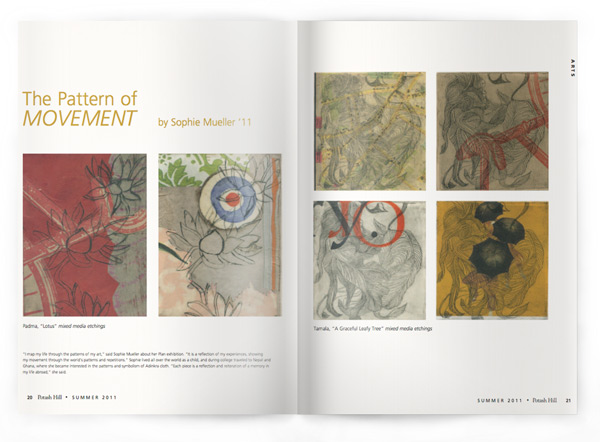
by Sophie Mueller ’11
“I map my life through the patterns of my art,” said Sophie Mueller about her Plan exhibition. “It is a reflection of my experiences, showing my movement through the world’s patterns and repetitions.” Sophie lived all over the world as a child, and during college traveled to Nepal and Ghana, where she became interested in the patterns and symbolism of Adinkra cloth. “Each piece is a reflection and reiteration of a memory in my life abroad,” she said.
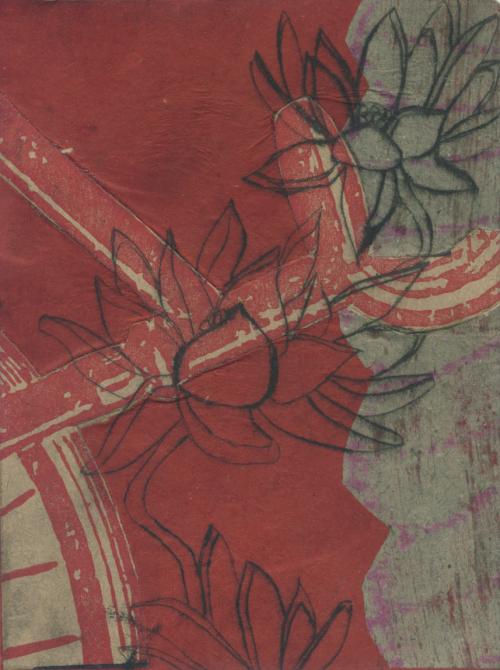 Padma, “Lotus” mixed media etchings
Padma, “Lotus” mixed media etchings
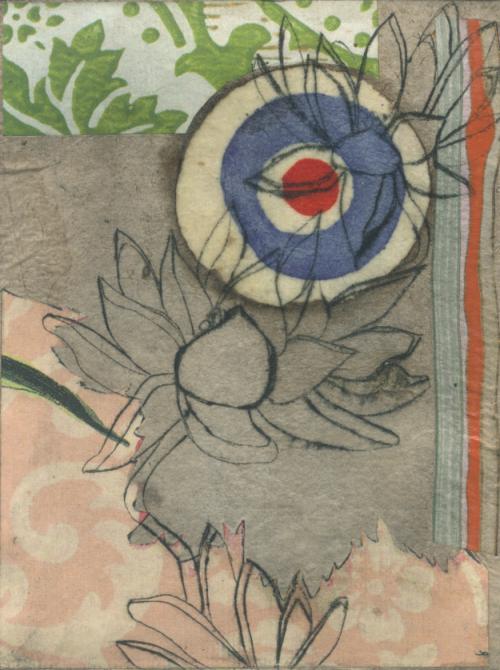
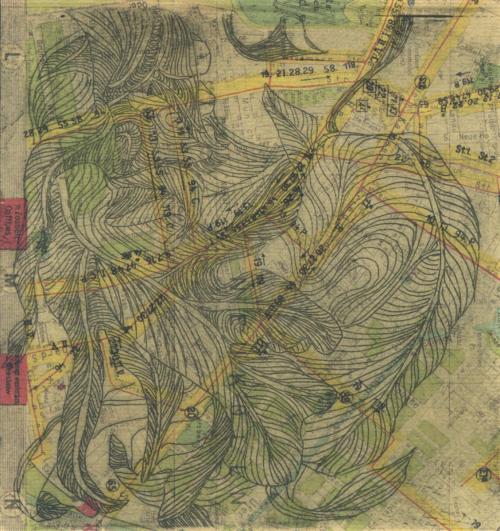
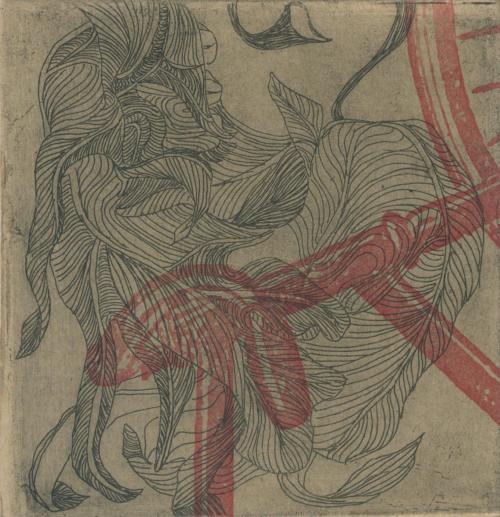

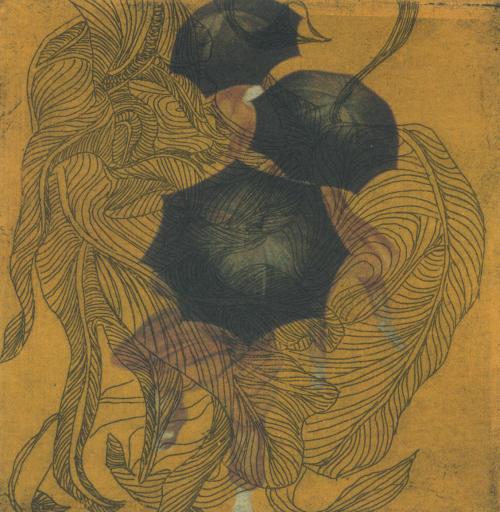 Tamala, “A Graceful Leafy Tree” mixed media etchings
Tamala, “A Graceful Leafy Tree” mixed media etchings
The Taste of Freedom
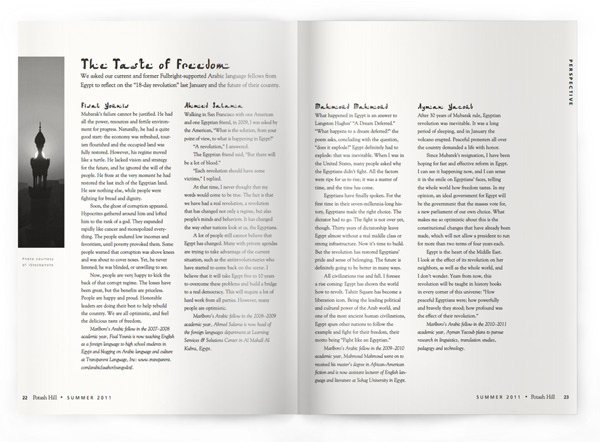
We asked our current and former Fulbright-supported Arabic language fellows from Egypt to reflect on the “18-day revolution” last January and the future of their country.
Fisal Younis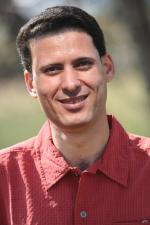 Mubarak’s failure cannot be justified. He had all the power, resources and fertile environment for progress. Naturally, he had a quite good start: the economy was refreshed, tourism flourished and the occupied land was fully restored. However, his regime moved like a turtle. He lacked vision and strategy for the future, and he ignored the will of the people. He froze at the very moment he had restored the last inch of the Egyptian land. He saw nothing else, while people were fighting for bread and dignity.
Mubarak’s failure cannot be justified. He had all the power, resources and fertile environment for progress. Naturally, he had a quite good start: the economy was refreshed, tourism flourished and the occupied land was fully restored. However, his regime moved like a turtle. He lacked vision and strategy for the future, and he ignored the will of the people. He froze at the very moment he had restored the last inch of the Egyptian land. He saw nothing else, while people were fighting for bread and dignity.
Soon, the ghost of corruption appeared. Hypocrites gathered around him and lofted him to the rank of a god. They expanded rapidly like cancer and monopolized everything. The people endured low incomes and favoritism, until poverty provoked them. Some people warned that corruption was above knees and was about to cover noses. Yet, he never listened; he was blinded, or unwilling to see.
Now, people are very happy to kick the back of that corrupt regime. The losses have been great, but the benefits are priceless. People are happy and proud. Honorable
leaders are doing their best to help rebuild the country. We are all optimistic, and feel the delicious taste of freedom.
Marlboro’s Arabic fellow in the 2007–2008 academic year, Fisal Younis is now teaching English as a foreign language to high school students in Egypt and blogging on Arabic language and culture at Transparent Language, Inc.
Ahmed Salama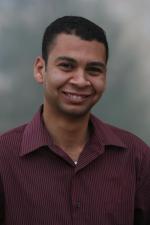 Walking in San Francisco with one American and one Egyptian friend, in 2009, I was asked by the American, “What is the solution, from your point of view, to what is happening in Egypt?”
Walking in San Francisco with one American and one Egyptian friend, in 2009, I was asked by the American, “What is the solution, from your point of view, to what is happening in Egypt?”
“A revolution,” I answered.
The Egyptian friend said, “But there will be a lot of blood.”
“Each revolution should have some victims,” I replied.
At that time, I never thought that my words would come to be true. The fact is that we have had a real revolution, a revolution that has changed not only a regime, but also people’s minds and behaviors. It has changed the way other nations look at us, the Egyptians.
A lot of people still cannot believe that Egypt has changed. Many with private agendas are trying to take advantage of the current situation, such as the antirevolutionaries who have started to come back on the scene. I believe that it will take Egypt five to 10 years to overcome these problems and build a bridge to a real democracy. This will require a lot of hard work from all parties. However, many people are optimistic.
Marlboro’s Arabic fellow in the 2008–2009 academic year, Ahmed Salama is now head of the foreign languages department at Learning Services & Solutions Center in Al Mahall Al Kubra, Egypt.
Mahmoud Mahmoud What happened in Egypt is an answer to Langston Hughes’ “A Dream Deferred.” “What happens to a dream deferred?” the poem asks, concluding with the question, “does it explode?” Egypt definitely had to explode: that was inevitable. When I was in the United States, many people asked why the Egyptians didn’t fight. All the factors were ripe for us to rise; it was a matter of time, and the time has come.
What happened in Egypt is an answer to Langston Hughes’ “A Dream Deferred.” “What happens to a dream deferred?” the poem asks, concluding with the question, “does it explode?” Egypt definitely had to explode: that was inevitable. When I was in the United States, many people asked why the Egyptians didn’t fight. All the factors were ripe for us to rise; it was a matter of time, and the time has come.
Egyptians have finally spoken. For the first time in their seven-millennia-long history, Egyptians made the right choice. The dictator had to go. The fight is not over yet, though. Thirty years of dictatorship leave Egypt almost without a real middle class or strong infrastructure. Now it’s time to build. But the revolution has restored Egyptians’ pride and sense of belonging. The future is definitely going to be better in many ways.
All civilizations rise and fall. I foresee a rise coming: Egypt has shown the world how to revolt. Tahrir Square has become a liberation icon. Being the leading political and cultural power of the Arab world, and one of the most ancient human civilizations, Egypt spurs other nations to follow the example and fight for their freedom, their motto being “Fight like an Egyptian.”
Marlboro’s Arabic fellow in the 2009–2010 academic year, Mahmoud Mahmoud went on to received his master’s degree in African-American fiction and is now assistant lecturer of English language and literature at Sohag University in Egypt.
Ayman Yacoub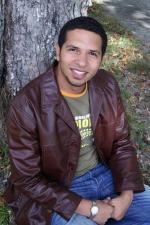 After 30 years of Mubarak rule, Egyptian revolution was inevitable. It was a long period of sleeping, and in January the volcano erupted. Peaceful protesters all over the country demanded a life with honor.
After 30 years of Mubarak rule, Egyptian revolution was inevitable. It was a long period of sleeping, and in January the volcano erupted. Peaceful protesters all over the country demanded a life with honor.
Since Mubarek’s resignation, I have been hoping for fast and effective reform in Egypt. I can see it happening now, and I can sense it in the smile on Egyptians’ faces, telling the whole world how freedom tastes. In my opinion, an ideal government for Egypt will be the government that the masses vote for, a new parliament of our own choice. What makes me so optimistic about this is the constitutional changes that have already been made, which will not allow a president to run for more than two terms of four years each.
Egypt is the heart of the Middle East. I look at the effect of its revolution on her neighbors, as well as the whole world, and I don’t wonder. Years from now, this
revolution will be taught in history books in every corner of this universe: “How
peaceful Egyptians were; how powerfully and bravely they stood; how profound was the effect of their revolution.”
Marlboro’s Arabic fellow in the 2010–2011 academic year, Ayman Yacoub plans to pursue research in linguistics, translation studies, pedagogy and technology.
On and Off the Hill
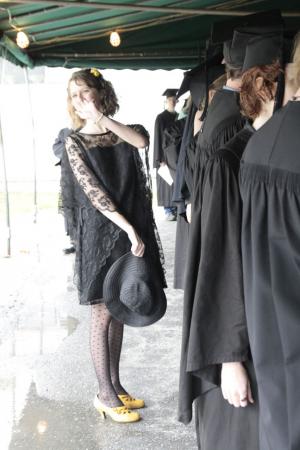 All the news that fits, including the Embodied Learning Symposium, Movies from Marlboro, a class trip to the baths of Caracalla and a meeting called SymBiotic Art and Science. Plus commencement, of course, and faculty, students and staff worthy of note.
All the news that fits, including the Embodied Learning Symposium, Movies from Marlboro, a class trip to the baths of Caracalla and a meeting called SymBiotic Art and Science. Plus commencement, of course, and faculty, students and staff worthy of note.
Symposium transcends mind-body dualism
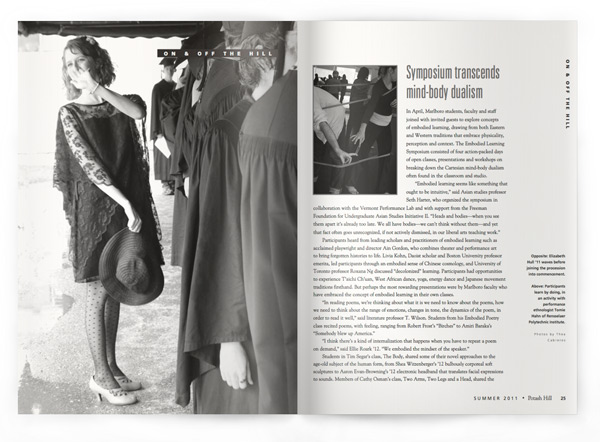
In April, Marlboro students, faculty and staff joined with invited guests to explore concepts of embodied learning, drawing from both Eastern and Western traditions that embrace physicality, perception and context. The Embodied Learning Symposium consisted of four action-packed days of open classes, presentations and workshops on breaking down the Cartesian mind-body dualism often found in the classroom and studio.
“Embodied learning seems like something that ought to be intuitive,” said Asian studies professor Seth Harter, who organized the symposium in collaboration with the Vermont Performance Lab and with support from the Freeman Foundation for Undergraduate Asian Studies Initiative II. “Heads and bodies—when you see them apart it’s already too late. We all have bodies—we can’t think without them—and yet that fact often goes unrecognized, if not actively dismissed, in our liberal arts teaching work.”
Participants heard from leading scholars and practitioners of embodied learning such as acclaimed playwright and director Ain Gordon, who combines theater and performance art to bring forgotten histories to life. Livia Kohn, Daoist scholar and Boston University professor emerita, led participants through an embodied sense of Chinese cosmology, and University of Toronto professor Roxana Ng discussed “decolonized” learning. Participants had opportunities to experience T’aichi Ch’uan, West African dance, yoga, energy dance and Japanese movement traditions firsthand. But perhaps the most rewarding presentations were by Marlboro faculty who have embraced the concept of embodied learning in their own classes.
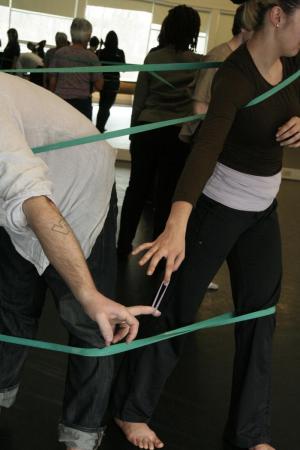 “In reading poems, we’re thinking about what it is we need to know about the poems, how we need to think about the range of emotions, changes in tone, the dynamics of the poem, in order to read it well,” said literature professor T. Wilson. Students from his Embodied Poetry class recited poems, with feeling, ranging from Robert Frost’s “Birches” to Amiri Baraka’s “Somebody blew up America.”
“In reading poems, we’re thinking about what it is we need to know about the poems, how we need to think about the range of emotions, changes in tone, the dynamics of the poem, in order to read it well,” said literature professor T. Wilson. Students from his Embodied Poetry class recited poems, with feeling, ranging from Robert Frost’s “Birches” to Amiri Baraka’s “Somebody blew up America.”
“I think there’s a kind of internalization that happens when you have to repeat a poem on demand,” said Ellie Roark ’12. “We embodied the mindset of the speaker.”
Students in Tim Segar’s class, The Body, shared some of their novel approaches to the age-old subject of the human form, from Shea Witzenberger’s ’12 bulbously corporeal soft sculptures to Aaron Evan-Browning’s ’12 electronic headband that translates facial expressions to sounds. Members of Cathy Osman’s class, Two Arms, Two Legs and a Head, shared the results of experimentally restraining their painting stroke to remind themselves of the physicality of painting. Students reported that they found the experiment freeing, even comforting, and the resulting figure paintings felt less contrived.
“‘I think therefore I am’ no longer sufficiently explains a lot of things that are going on in terms of social movements inspired by desires,” said politics professor Meg Mott in a presentation from her class, Spinoza & Freedom. She described going beyond students’ thoughts to make their emotional reactions to subjects part of the class discussion. “Maybe Spinoza’s tagline would be ‘I think I am affected, therefore I am empowered.”
Visiting language professor Michael Huffmaster discussed the bodily basis of semantics and thought, and ceramics professor Martina Lantin and visiting photography professor Lakshmi Luthra ’05 discussed art theory and practice. Anthropology professor Carol Hendrickson and Sari Brown ’11 talked about their recent visit to Bolivia, inspired by Sari’s field research there and by a course taught last fall by Carol and religion professor Amer Latif called Thinking Through the Body.
“Starting a few years ago, in the course of conversations with students and colleagues, I started to see a strange phenomenon—people started to talk about these ideas of embodiment,” said Seth, who led a discussion based on his class, Making Way: Daoist Ritual and Practice. “People started to question the epistemological significance of the connections between the mind and the body and the cost of ignoring those connections. They questioned bracketing out feelings or emotions or sensory input or physical limitation from the kind of work we were doing, even in history class or philosophy class. I saw the Embodied Learning Symposium as an opportunity for those conversations to come together.”
College launches film intensive
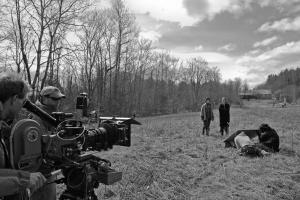 Film studies students have found significant opportunities to work with professor Jay Craven, from assisting on the set of his 2007 feature film, Disappearances, to collaborating on Marble Hill, a television sitcom based on a small, liberal arts college in Vermont. Next spring the college will take film studies to a new level, through an intensive program that partners college students with seasoned filmmakers for the production of a dramatic feature film starring professional actors and aimed for national release.
Film studies students have found significant opportunities to work with professor Jay Craven, from assisting on the set of his 2007 feature film, Disappearances, to collaborating on Marble Hill, a television sitcom based on a small, liberal arts college in Vermont. Next spring the college will take film studies to a new level, through an intensive program that partners college students with seasoned filmmakers for the production of a dramatic feature film starring professional actors and aimed for national release.
Movies from Marlboro, a semester-long film intensive, starts in January 2012 with a week at the Sundance Film Festival. This will be followed by “north country” literature and cinema study as well as hands-on preparation and production of a film based on Howard Frank Mosher’s award-winning novel Northern Borders.
“This new film intensive program grows out of my long experience working with young filmmakers and my years of producing and releasing north country films produced on significantly larger budgets,” said Jay. “Based on these experiences and new developments in independent film production and distribution, I believe that this Marlboro College film intensive will provide a rich learning opportunity and help chart a new course for how independent films get made and distributed.”
Eight film professionals will mentor up to 20 college students and play leading roles as department heads for the film. Independent filmmaker Chip Hourihan, who produced the Academy Award–nominated Frozen River, will partner with Jay to produce the film on a contract with the Screen Actors Guild. Based on their interest and experience, students will earn both college credit and professional film credit as they study, train and practice in every corner of production—as actors, camera operators, unit directors, producers, set designers, costume designers, production assistants and more.
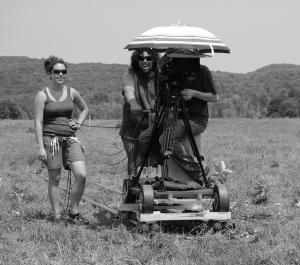 “Marlboro College has, since its founding, believed in students’ potential to take on substantial leadership and responsibility and to challenge themselves on ambitious and potentially transformative Projects,” said Ellen McCulloch-Lovell, president. “This Project is a perfect fit for us, and I’m especially pleased that we’ll launch it using the work of one of Vermont’s most talented writers, Howard Frank Mosher, who has done so much to enlarge our imagination of our region.”
“Marlboro College has, since its founding, believed in students’ potential to take on substantial leadership and responsibility and to challenge themselves on ambitious and potentially transformative Projects,” said Ellen McCulloch-Lovell, president. “This Project is a perfect fit for us, and I’m especially pleased that we’ll launch it using the work of one of Vermont’s most talented writers, Howard Frank Mosher, who has done so much to enlarge our imagination of our region.”
Jay envisions participation that will include undergraduate and graduate students in not only film but also theater, visual arts and photography. Students from other U.S. colleges are eligible to apply for the program, joining with Marlboro students on the Project.
“Motivated college students possess keen intelligence, formidable skills and a strong desire to work on Projects that engage them,” Jay said. “They can do the work required to make a first-class film, serving in leadership roles and guided by professionals. My own experience shows me that nothing helps to accelerate an emerging filmmaker’s path more quickly than this kind of intensive exposure, which can otherwise take years to achieve. We’re working to give students a chance—sooner than they might otherwise have—to intensify their practice and earn a substantial film credit to help launch their careers.”
For more information, go to movies.marlboro.edu or contact Jay Craven.
Students lay siege to Rome
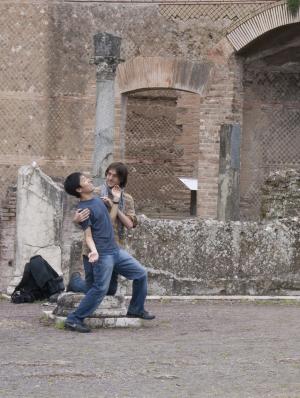 “The ruins of Rome can be hard to comprehend secondhand,” said classics fellow William Guast, who taught a class this spring semester called Rethinking Rome: Power, Society and Faith in the Roman Empire. “Many sites are too large or too complex for their layout, function or impact to be fully comprehended in printed form.” In March, William’s class had a chance to experience Roman history firsthand, through the art, architecture and archaeology of the city of Rome itself and other sites nearby.
“The ruins of Rome can be hard to comprehend secondhand,” said classics fellow William Guast, who taught a class this spring semester called Rethinking Rome: Power, Society and Faith in the Roman Empire. “Many sites are too large or too complex for their layout, function or impact to be fully comprehended in printed form.” In March, William’s class had a chance to experience Roman history firsthand, through the art, architecture and archaeology of the city of Rome itself and other sites nearby.
“I experienced the actual scope of history,” said Sam King ’12, one of the nine students who participated and who is designing a Plan of Concentration on utopias. “Reading about Trajan’s Column, you don’t realize how big it is. That’s big in a symbolic sense, ancient and powerful and so on, but also very, very tall and hard to read. I was constantly in awe.”
William’s class considered how the Roman emperors tried to control their image through art and architecture, from the palaces they had built for themselves to the baths and amphitheaters with which they hoped to entertain the masses. Some of the highlights of their trip included the Colosseum (of course), the huge baths of Caracalla and a day trip to the Roman port town of Ostia to learn about the lives of the urban poor.
“A particular and unexpected highlight was the church of San Clemente, built on top of an early Christian basilica, which was itself built on top of a first-century temple to the god Mithras and an apartment block,” said William. The students were intrigued by the radically unfamiliar Roman religious system, visiting the great pagan temples such as the Pantheon, the dark catacombs where Christians and Jews were laid to rest and the monumental churches that heralded the final triumph of Christianity. “Another favorite was Rome’s cat sanctuary, situated in the ruins of four Roman temples.”
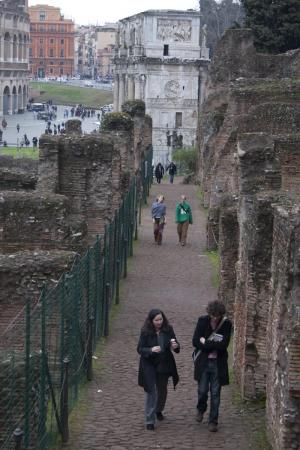 “All the different landmarks that we read about in our Roman history readings were now tangible and accessible,” said Paul Lee ’14, who is interested in history and, now, learning Italian. “We got to visit so many historic sites that came alive in a way they couldn’t by simply looking at pictures or reading about them.”
“All the different landmarks that we read about in our Roman history readings were now tangible and accessible,” said Paul Lee ’14, who is interested in history and, now, learning Italian. “We got to visit so many historic sites that came alive in a way they couldn’t by simply looking at pictures or reading about them.”
Students were asked to analyze these monuments and sites in person, as ancient Romans would have experienced them. As they moved about the city, they explored the relationship of one monument to another, such as Trajan’s “triad” of interrelated monuments—his forum, his column and his markets—or the emperors’ successive attempts to outdo one another in monuments on the Campus Martius.
“We’ve been discussing Roman town planning in class, and it was great to be able to say ‘in towns like Ostia, or Pompeii’ and know that the students had firsthand experience of what we were talking about,” said William. “When we came to Roman religion, it was great to be able to refer to ‘early Christian art’ and know that the students had seen countless examples in Rome’s museums.”
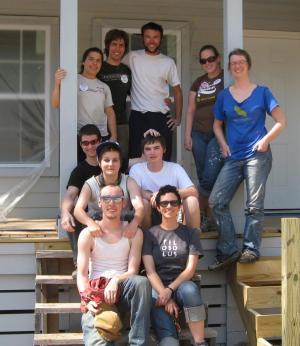 Meanwhile, during one of the longest winters in recent memory, a different group of Marlboro students visited springtime during Spring Break, traveling to South Carolina to do community service work with Habitat for Humanity. Pictured left to right are (top row) Hannah Ruth Brothers ’13, Casey Friedman ’12, Jonathan Wood ’12, counseling intern Allison Fisette, Emily Field ’11, (middle row) Randy Morantes ’14, Shyloh Favreau ’13, David Amato ’13, (front row) Nick Rouke ’12 and Clare Hipschman, student life coordinator.
Meanwhile, during one of the longest winters in recent memory, a different group of Marlboro students visited springtime during Spring Break, traveling to South Carolina to do community service work with Habitat for Humanity. Pictured left to right are (top row) Hannah Ruth Brothers ’13, Casey Friedman ’12, Jonathan Wood ’12, counseling intern Allison Fisette, Emily Field ’11, (middle row) Randy Morantes ’14, Shyloh Favreau ’13, David Amato ’13, (front row) Nick Rouke ’12 and Clare Hipschman, student life coordinator.Meeting explores symbiosis of art and science
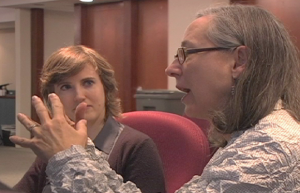 In March, a group of leading scholars in the life sciences, literature, visual arts and dance gathered at the National Science Foundation (NSF) in Arlington, Virginia, to explore what happens when artists and scientists work together. The conference, called “SymBiotic Art and Science,” was conceived by Marlboro President Ellen McCulloch-Lovell and colleague Dr. Christopher Comer, a neuroscientist and dean of the College of Arts and Sciences at the University of Montana.
In March, a group of leading scholars in the life sciences, literature, visual arts and dance gathered at the National Science Foundation (NSF) in Arlington, Virginia, to explore what happens when artists and scientists work together. The conference, called “SymBiotic Art and Science,” was conceived by Marlboro President Ellen McCulloch-Lovell and colleague Dr. Christopher Comer, a neuroscientist and dean of the College of Arts and Sciences at the University of Montana.
“Where the arts and sciences come together they are creating a new synthesis, new ways of knowing,” said Ellen. “The scientists call on the artists to ‘re-enchant the world,’ and the artists need the scientists to observe and understand the world. The artists talked about their experiments, and the scientists their intuitive leaps. They found that not only do artists and scientists inform each other’s work, they can also cooperate to generate new creativity. However, this kind of collaboration is not often recognized within academic arenas or by funding agencies.”
Co-sponsored by the NSF and the National Endowment for the Arts, the meeting involved 24 participants ranging from Liz Lerman, founding artistic director of the Liz Lerman Dance Exchange, to University of Vermont theoretical biologist Stuart Kauffman. Included were an art photographer who specialized in images of scientific experiments, a psychologist who analyzed literary characters and a rainforest ecologist who invited a Detroit rap artist into the forest canopy to communicate with urban youth about forest preservation. Participants from biology, astronomy, performance art, biomimicry, dance, painting, art conservation, bio-art, ecology and geology enriched the agenda as they mapped the range of possibilities.
“I have never considered my engagement in science as distinct from my activity as an artist,” said Bevil Conway, who teaches neuroscience at Wellesley College, with a focus on visual perception. “Although art and science differ in their modes of production, their expert communities and often their quantifiable utility, both avenues of investigation have provided me with a mechanism to appreciate, and hopefully uncover, the mysteries of perception. Both are fun.”
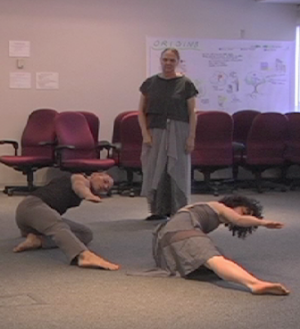 “The whole symposium was incredibly relevant to what we do here at Marlboro,” said dance professor Kristin Horrigan, who co-taught an Anatomy of Movement class with biology professor Jaime Tanner last fall. “I think that the big message I took home was that we could do a lot more of this, and it would be really healthy for our campus if we made a deliberate effort to create
“The whole symposium was incredibly relevant to what we do here at Marlboro,” said dance professor Kristin Horrigan, who co-taught an Anatomy of Movement class with biology professor Jaime Tanner last fall. “I think that the big message I took home was that we could do a lot more of this, and it would be really healthy for our campus if we made a deliberate effort to create
more art-science connections.” Rounding out the Marlboro contingent were alumna Melanie Gifford ’73, who works at the National Gallery as a conservator of 16th- and 17th-century paintings, and film student Jesse Nesser ’13, who documented the meeting.
“There was a spontaneous and very poignant discussion about the conditions under which this work happens and flourishes, about generative environments,” said Ellen. The majority of participants who had academic affiliations were from small liberal arts colleges, and two from big universities admitted that they collaborated across disciplines in spite of their institutions. When participants from Europe pointed out that European colleges offer combination art-science degrees, it didn’t escape Ellen and Kristin and Melanie and Jesse that this is also possible at Marlboro. “When you think about generative environments, it is incredibly reinforcing of our Marlboro model,” said Ellen.
Black History Month events accentuate the positive
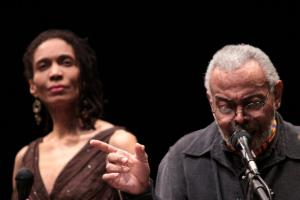 If you had an interest in pop music during the 1960s civil rights movement, the Harlem Renaissance or 19th-century African-American farmers in Vermont, Marlboro was the place to be in February. For Black History Month, the college had a wide array of events celebrating the contributions of African-Americans to American culture and society.
If you had an interest in pop music during the 1960s civil rights movement, the Harlem Renaissance or 19th-century African-American farmers in Vermont, Marlboro was the place to be in February. For Black History Month, the college had a wide array of events celebrating the contributions of African-Americans to American culture and society.
Vermont historian Elise Guyette kicked off the program with a discussion of her book Discovering Black Vermont: African-American Farmers in Hinesburgh, Vermont, 1790–1890. The book, which won the 2010 Award of Excellence from the Vermont Historical Society, tells the story of a small black community in northern Vermont that was apparently accorded fair treatment and respect from its white neighbors during a period of U.S. history that spans legalized slavery and Jim Crow laws. Guyette’s lecture took the audience through her process of discovering court documents, town records, newspaper articles and other primary sources to construct what the Valley News calls “a quintessential Vermont pioneering story.”
Later in the month, legendary jazz bassist William Parker brought an octet to the Whittemore Theater to perform music from his 2010 release, I Plan to Stay a Believer: The Inside Songs of Curtis Mayfield. Parker’s group included poet, playwright and activist Amiri Baraka, who founded the Black Arts Movement in Harlem during the 1960s and authored the Obie-winning play Dutchman. Parker and other band members also met with students and faculty to discuss the intersection between art and social consciousness during that era among African-Americans in general, and Curtis Mayfield in particular.
“If you had ears to hear, you knew that Curtis was a man with a positive message—a message that was going to help you to survive,” Parker said. His band performed jazz renditions of Mayfield’s songs, such as “People Get Ready,” “Move on Up” and “Keep on Pushing,” which became anthems of black power and black pride in the 1960s and ’70s.
The final event was a lecture and reading by author and University of Vermont Professor Emily Bernard, entitled “Carl Van Vechten and the Harlem Renaissance.” Bernard discussed the power and potential of interracial friendships through the historical lens of Van Vechten’s role as patron during this early 20th-century period.
“There was really no one like Van Vechten,” said Bernard, whose book Carl Van Vechten: A Life in Black and White will be published by Yale University press later this year. “He did everything he could to promote black artists, he wrote articles and he had parties. He was a genius at throwing parties.” She described how the relationships formed in his apartment, at a time when clubs and other social venues were highly segregated, set the stage for the patronage of many influential artists, from Langston Hughes to Zora Neale Hurston.
Videos of full lectures are available at our website.
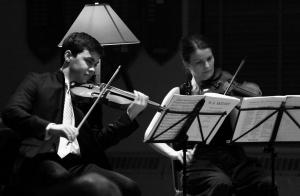 In April, a year of concerts in honor of retiring music professor Luis Battle culminated in a final concert featuring musicians from Marlboro Music. A touring quintet consisting of Benjamin Beilman (violin, pictured left), Veronika Eberle (violin, pictured right), Beth Guterman (viola), Yura Lee (viola) and Judith Serkin (cello) performed a program of Mozart, Haydn and Dvorak.
In April, a year of concerts in honor of retiring music professor Luis Battle culminated in a final concert featuring musicians from Marlboro Music. A touring quintet consisting of Benjamin Beilman (violin, pictured left), Veronika Eberle (violin, pictured right), Beth Guterman (viola), Yura Lee (viola) and Judith Serkin (cello) performed a program of Mozart, Haydn and Dvorak.
Worthy of Note
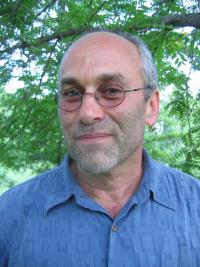 Marlboro congratulates photography professor John Willis for receiving a fellowship award from the John Simon Guggenheim Memorial Foundation in April. John is one of 180 scholars, artists and scientists chosen from almost 3,000 applicants across the country. His application included work from his 2010 book, Views from the Reservation (Potash Hill, Winter 2011), as well as his 2002 Recycled Realities (Potash Hill, Summer 2001), in addition to other endeavors. John plans to use the award to continue pursuing artistic projects that integrate his work at Marlboro with the youth programs he has helped establish, the In-Sight Photography Project in Brattleboro and the Exposures cross-cultural youth arts program.
Marlboro congratulates photography professor John Willis for receiving a fellowship award from the John Simon Guggenheim Memorial Foundation in April. John is one of 180 scholars, artists and scientists chosen from almost 3,000 applicants across the country. His application included work from his 2010 book, Views from the Reservation (Potash Hill, Winter 2011), as well as his 2002 Recycled Realities (Potash Hill, Summer 2001), in addition to other endeavors. John plans to use the award to continue pursuing artistic projects that integrate his work at Marlboro with the youth programs he has helped establish, the In-Sight Photography Project in Brattleboro and the Exposures cross-cultural youth arts program.
Recently retired (but never slowing down) biology professor Bob Engel taught a class in ornithology this spring at the Osher Lifelong Learning Institute, a continuing education program for seniors in Brattleboro. Also featured this spring was anthropology professor Carol Hendrickson, discussing indigenous peoples of Latin America in the 21st century. These Marlboro faculty members continue a long tradition of sharing their scholarship with elder community members at Osher, including in recent years William Edelglass, Lynette Rummel, Amer Latif, Meg Mott and Geri Pittman de Batlle.
“I explore functional forms that reflect industrial traditions, seeking to make work that may be, in some way, indicative of the eminence of the owner,” writes ceramics professor Martina Lantin in an article in the March/April 2011 issue of Pottery Making Illustrated. Titled “A Crowning Achievement,” the article describes Martina’s inspiration and technique for creating “crown jars,” original designs that combine functionality with decorative qualities reminiscent of Wedgwood and other status-symbol ceramics of the early industrial era. “My crown jars are equally capable of holding the collected bounty of a batch of cookies or the ideas and aspirations of its owner.”
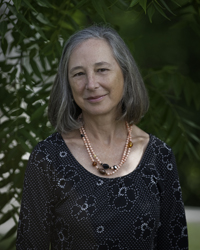 Anyone who has attended staff-faculty readings at the college has been delighted to learn that Marlboro’s president, Ellen McCulloch-Lovell, is also an accomplished poet. Last winter marked the publication of a fine book of poems by Ellen, Gone, in a limited edition from the acclaimed art book publisher Janus Press. Gone is illustrated with a lithograph by Janus founder Claire Van Vliet and includes 21 of Ellen’s poems printed on handmade paper from a mill in Maidstone, England.
Anyone who has attended staff-faculty readings at the college has been delighted to learn that Marlboro’s president, Ellen McCulloch-Lovell, is also an accomplished poet. Last winter marked the publication of a fine book of poems by Ellen, Gone, in a limited edition from the acclaimed art book publisher Janus Press. Gone is illustrated with a lithograph by Janus founder Claire Van Vliet and includes 21 of Ellen’s poems printed on handmade paper from a mill in Maidstone, England.
“Where else is a nuclear disaster in the world’s only A-bombed country more potent than in the world’s first A-bombed city?” asked Andrew Tanabe ’12, reporting from his World Studies Program internship in Hiroshima, Japan. He was working at the Hiroshima Peace Culture Foundation, doing research and translation as well as helping to create a model “Peace Culture” that includes a clean energy economy and local food systems. In the wake of the nuclear disaster in northeast Japan, he was surprised to learn that Japanese citizens do not often connect nuclear weapons with nuclear power. “Interestingly, I think this sentiment is particularly strong in Hiroshima,” Andrew said.
“As a research tool, and a way to make some friends, I have been learning my way around a root of ginger, a clove of garlic, a spoon, a wok and some fatty pork,” said World Studies Program student Zack Chilcote ’13. He is spending a year in Beijing, teaching English at a Montessori school and researching the social impacts of China’s “one child” policy. He hopes that the school will provide guanxi (connections) for his research, but he’s finding the quickest way to meet people is to cook for them. “Research gives me the ability to say something that perhaps other people have not thought of before, and then actually explore it until it becomes real to me.”
Brenda Foley, theater professor and director of the World Studies Program, presented a paper in May at an interdisciplinary meeting in Warsaw called “Probing the Boundaries, Making Sense of Pain.” In the paper, which combines theory from the fields of disability and performance studies, Brenda explores how performance can be used to disrupt a socially constructed public image of disability that denies the reality of visible pain. “Culturally we perpetuate a hierarchy of disability according to visible difference,” she said. “We like our disabilities to be neat and tidy, not messy, sloppy, ugly or contorted in pain. But the potential exists in performance to blur that societal inscription.”
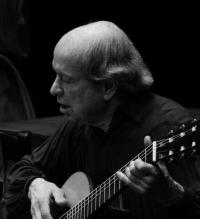 Not everyone celebrates their birthday with a terzetto from Mozart’s Magic Flute and a fountain of molten chocolate. But then, not everyone is retired language professor Edmund Brelsford. In March the venerable Marlboro Recorder Workshop, founded by Edmund, celebrated its 47th-anniversary concert season and Edmund’s 80th with a concert in Ragle Hall. The ensemble presented vocal and instrumental music of the Middle Ages, the Renaissance and the baroque and classical periods. Their concert paid homage to the late Blanche Honegger Moyse, as well as to retiring Marlboro colleague Luis Batlle, and was followed by a reception with cake and, yes, molten chocolate for dipping strawberries.
Not everyone celebrates their birthday with a terzetto from Mozart’s Magic Flute and a fountain of molten chocolate. But then, not everyone is retired language professor Edmund Brelsford. In March the venerable Marlboro Recorder Workshop, founded by Edmund, celebrated its 47th-anniversary concert season and Edmund’s 80th with a concert in Ragle Hall. The ensemble presented vocal and instrumental music of the Middle Ages, the Renaissance and the baroque and classical periods. Their concert paid homage to the late Blanche Honegger Moyse, as well as to retiring Marlboro colleague Luis Batlle, and was followed by a reception with cake and, yes, molten chocolate for dipping strawberries.
Those who read the last issue of Potash Hill (Winter 2011) will remember Sari Brown’s ’11 field research on gender and religion in Bolivia. This spring, Sari returned to Bolivia with anthropology professor Carol Hendrickson, supported by an Aron Grant, to look beyond discursive methods of documenting life in and around La Paz. They created artwork, recorded street sounds, took series of photos in stop-motion style and brought back food and garments from Bolivia’s rich material culture. “It was really interesting for me to go back and try to be conscientious about taking things in on a more bodily, sensorial level and looking for nondiscursive forms of meaning and communicating,” said Sari.
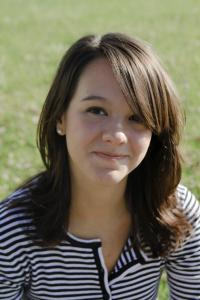 During winter break, Emily Mente ’11 joined students from across the country for a week of workshops and meetings in New York City called Feminist Winter Term. Initiated by Soapbox Inc., the program brings young feminists together to broaden their horizons and show them what kinds of jobs are available with a gender studies degree. “It really gave us an idea of what the feminist landscape of New York City looks like,” said Emily, who even tagged along with one of the organizers for a meeting with Gloria Steinem. “I was so star-struck,” she said.
During winter break, Emily Mente ’11 joined students from across the country for a week of workshops and meetings in New York City called Feminist Winter Term. Initiated by Soapbox Inc., the program brings young feminists together to broaden their horizons and show them what kinds of jobs are available with a gender studies degree. “It really gave us an idea of what the feminist landscape of New York City looks like,” said Emily, who even tagged along with one of the organizers for a meeting with Gloria Steinem. “I was so star-struck,” she said.
Philosophy professor William Edelglass writes, “It seems to be a natural development in all literate societies, and in many nonliterate societies as well, to ask difficult questions about the fundamental nature of reality, about what it is to be human, about what constitutes a good life, about the nature of beauty and about how we can know any of these things.” William and colleague Jay L. Garfield edited The Oxford Handbook of World Philosophy (ISBN 978-0-19-532899-8), published by Oxford this year, co-authoring the introduction and the chapter on Indo-Tibetan Buddhist philosophy. His recent publications also include a bibliographic essay on Buddhist philosophy for the Oxford Bibliographies Online.
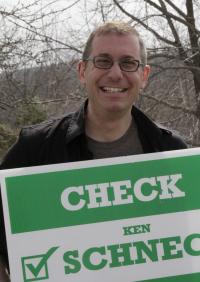 As if being dean of students and hosting a nationally syndicated radio show is not keeping him busy enough, Ken Schneck went ahead and got elected to the Brattleboro Town Selectboard with 59 percent of the vote in March. His goal, as always, is to invite as many voices to contribute to town discussions and decisions as possible. “Our town government has not yet embraced social media,” said Ken. “In fact, we’ve barely said hello to electronic media. I want to create different avenues of participation for Brattleboro citizens to be heard, diversifying the communication stream as much as possible. Also, bringing some levity to the process? Not such a bad thing.”
As if being dean of students and hosting a nationally syndicated radio show is not keeping him busy enough, Ken Schneck went ahead and got elected to the Brattleboro Town Selectboard with 59 percent of the vote in March. His goal, as always, is to invite as many voices to contribute to town discussions and decisions as possible. “Our town government has not yet embraced social media,” said Ken. “In fact, we’ve barely said hello to electronic media. I want to create different avenues of participation for Brattleboro citizens to be heard, diversifying the communication stream as much as possible. Also, bringing some levity to the process? Not such a bad thing.”
“I’m off getting some fresh, new stories and insights to enliven my African Politics course this fall,” Lynette Rummel wrote from her adventures in Mali, where she spent three weeks of spring sabbatical. Lynette plans to use Mali as a case study country, to explore and examine the more general trends and patterns that she presents in class. “I’ve never been to Mali before, so it will make it new and exciting to reconsider common arguments and larger contours in a new and different light. For example, I wonder if many Americans are aware of our involvement in this country as a front against, you guessed it, al Qaida in the Maghreb.”
Apparently not one to sit still for long, art professor Felicity Ratté spent her 2010–11 sabbatical year studying Islamic art and architecture around the Mediterranean region. Starting last August, Felicity explored Spain, Morocco, Tunisia, Egypt, Syria, Iraq, Turkey and Bulgaria, finally ending her travels in Venice. She photographed vaulted domes and minarets from Kairouan to Kurdistan in an effort to better understand how medieval city-dwellers used their urban landscape. “Now I need to sit down and make some sense out of it all,” Felicity said, but again, sitting is not her strength. In May she presented preliminary findings in a conference paper titled “The celebrated city in the Mediterranean: possibilities for comparison between Florence and Cairo, c. 1300,” in Corfu.
Be sure to get the latest scoop on Potash Hill at these sites:
Commencement 2011
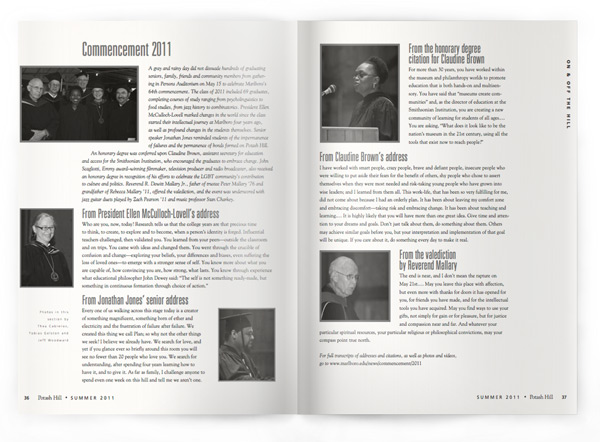
A gray and rainy day did not dissuade hundreds of graduating seniors, family, friends and community members from gathering in Persons Auditorium on May 15 to celebrate Marlboro’s 64th commencement. The class of 2011 included 69 graduates, completing courses of study ranging from psycholinguistics to food studies, from jazz history to combinatorics. President Ellen McCulloch-Lovell marked changes in the world since the class started their intellectual journey at Marlboro four years ago, as well as profound changes in the students themselves. Senior speaker Jonathan Jones reminded students of the impermanence of failures and the permanence of bonds formed on Potash Hill. An honorary degree was conferred upon Claudine Brown, assistant secretary for education and access for the Smithsonian Institution, who encouraged the graduates to embrace change. John Scagliotti, Emmy award–winning filmmaker, television producer and radio broadcaster, also received an honorary degree in recognition of his efforts to celebrate the LGBT community’s contribution to culture and politics. Reverend R. Dewitt Mallary Jr., father of trustee Peter Mallary ’76 and grandfather of Rebecca Mallary ’11, offered the valediction, and the event was underscored with jazz guitar duets played by Zach Pearson ’11 and music professor Stan Charkey.
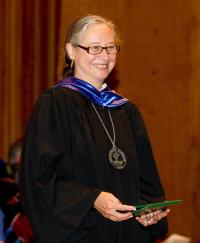 From President Ellen McCulloch-Lovell’s address
From President Ellen McCulloch-Lovell’s address
Who are you, now, today? Research tells us that the college years are that precious time to think, to create, to explore and to become, when a person’s identity is forged. Influential teachers challenged, then validated you. You learned from your peers—outside the classroom and on trips. You came with ideas and changed them. You went through the crucible of confusion and change—exploring your beliefs, your differences and biases, even suffering the loss of loved ones—to emerge with a stronger sense of self. You know more about what you are capable of, how convincing you are, how strong, what lasts. You know through experience what educational philosopher John Dewey said: “The self is not something ready-made, but something in continuous formation through choice of action.”
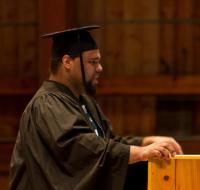 From Jonathan Jones’ senior address
From Jonathan Jones’ senior address
Every one of us walking across this stage today is a creator of something magnificent, something born of ether and electricity and the frustration of failure after failure. We created this thing we call Plan; so why not the other things we seek? I believe we already have. We search for love, and yet if you glance ever so briefly around this room you will see no fewer than 20 people who love you. We search for understanding, after spending four years learning how to have it, and to give it. As far as family, I challenge anyone to spend even one week on this hill and tell me we aren’t one.
From the honorary degree citation for Claudine Brown
For more than 30 years, you have worked within the museum and philanthropy worlds to promote education that is both hands-on and multisensory. You have said that “museums create communities” and, as the director of education at the Smithsonian Institution, you are creating a new community of learning for students of all ages.… You are asking, “What does it look like to be the nation’s museum in the 21st century, using all the tools that exist now to reach people?”
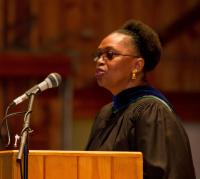 From Claudine Brown’s address
From Claudine Brown’s address
I have worked with smart people, crazy people, brave and defiant people, insecure people who were willing to put aside their fears for the benefit of others, shy people who chose to assert themselves when they were most needed and risk-taking young people who have grown into wise leaders; and I learned from them all. This work-life, that has been so very fulfilling for me, did not come about because I had an orderly plan. It has been about leaving my comfort zone and embracing discomfort—taking risk and embracing change. It has been about teaching and learning.… It is highly likely that you will have more than one great idea. Give time and attention to your dreams and goals. Don’t just talk about them, do something about them. Others may achieve similar goals before you, but your interpretation and implementation of that goal will be unique. If you care about it, do something every day to make it real.
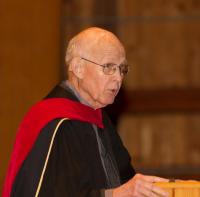 From the valediction by Reverend Mallary
From the valediction by Reverend Mallary
The end is near, and I don’t mean the rapture on May 21st…. May you leave this place with affection, but even more with thanks for doors it has opened for you, for friends you have made, and for the intellectual tools you have acquired. May you find ways to use your gifts, not simply for gain or for pleasure, but for justice and compassion near and far. And whatever your particular spiritual resources, your particular religious or philosophical convictions, may your compass point true north.
For full transcripts of addresses and citations, a list of 2011 graduates and their Plans of Concentration as well as photos and videos, go to Marlboro's Commencement 2011 site.
Academic Prizes
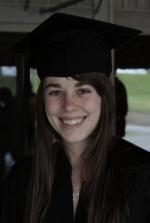 The Rebecca Willow Prize, established in 2008 in memory of Rebecca Willow, class of 1995, is awarded to students whose presence bring personal integrity and kindness to the community and who unite an interest in human history and culture with a passion for the natural world. Casey Chalbeck and Amanda Whiting
The Rebecca Willow Prize, established in 2008 in memory of Rebecca Willow, class of 1995, is awarded to students whose presence bring personal integrity and kindness to the community and who unite an interest in human history and culture with a passion for the natural world. Casey Chalbeck and Amanda Whiting
The Audrey Alley Gorton Award is given in memory of Audrey Gorton, Marlboro alumna and member of the faculty for 33 years, to the student who best reflects the Gorton qualities of: passion for reading, independence of critical judgment, fastidious attention to matters of style and a gift for intelligent conversation. Emma Goldhammer
The Hilly van Loon Prize, established by the class of 2000 in honor of Hilly van Loon, Marlboro class of 1962 and staff member for 23 years, is given to the seniors who best reflect Hilly’s wisdom, compassion, community involvement, quiet dedication to the spirit of Marlboro College, joy in writing and celebration of life. Eric Toldi and Kelly Ahrens
The William Davisson Prize, created by the Town Meeting Selectboard and named in honor of Will Davisson, who served as a faculty member for 18 years and as a trustee for 22 years, is awarded to one or more students for extraordinary contributions to the Marlboro community. Anna Knecht and Sarah Verbil
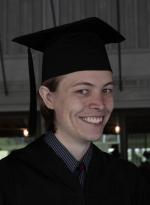 The Ryan Larsen Memorial Prize was established in 2006 in memory of Ryan Jeffrey Larsen, who felt transformed by the opportunities to learn and grow within the embrace of the Marlboro College community. It is awarded annually to juniors or seniors who best reflect Ryan’s qualities of philosophical curiosity, creativity, compassion and spiritual inquiry. Michael Thompson and Sari Brown
The Ryan Larsen Memorial Prize was established in 2006 in memory of Ryan Jeffrey Larsen, who felt transformed by the opportunities to learn and grow within the embrace of the Marlboro College community. It is awarded annually to juniors or seniors who best reflect Ryan’s qualities of philosophical curiosity, creativity, compassion and spiritual inquiry. Michael Thompson and Sari Brown
The Helen W. Clark Prize is awarded by the visual arts faculty for the best Plans of Concentration in the fine arts. Sophie Mueller and Lex Kosieradzki
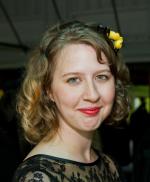 The Sally and Valerio Montanari Theater Prize is awarded annually to a graduating senior who has made the greatest overall contribution to the pursuit of excellence in theater production. Elizabeth Hull
The Sally and Valerio Montanari Theater Prize is awarded annually to a graduating senior who has made the greatest overall contribution to the pursuit of excellence in theater production. Elizabeth Hull
The Dr. Loren C. Bronson Award for Excellence in Classics, established by the family of Loren Bronson, class of 1973, is awarded to encourage undergraduate work in classics. Emily Kimble and Amanda Whiting
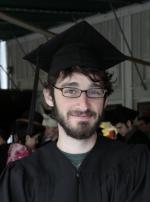 The Roland W. Boyden Prize is given by the humanities faculty to students who have demonstrated excellence in the humanities. Roland Boyden was a founding faculty member of the college, acting president, dean and trustee. Eric Breeden and Michael Mirer
The Roland W. Boyden Prize is given by the humanities faculty to students who have demonstrated excellence in the humanities. Roland Boyden was a founding faculty member of the college, acting president, dean and trustee. Eric Breeden and Michael Mirer
The Buck Turner Prize is awarded to a student who demonstrates excellence in the natural sciences, who uses interdisciplinary approaches, and who places his or her work in the context of larger questions. Chrissy Raudonis
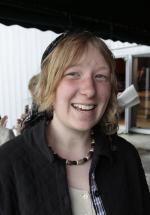 The Freshman/Sophomore Essay Prize is given annually for the best essay written for a Marlboro course. Kathryn Lyon; honorable mention, Adam Halwitz
The Freshman/Sophomore Essay Prize is given annually for the best essay written for a Marlboro course. Kathryn Lyon; honorable mention, Adam Halwitz
The Robert H. MacArthur Prize was established in 1973 in memory of Robert MacArthur, class of 1951, and recently rededicated to Robert and also to John and to John and Robert’s parents, John and Olive MacArthur, who founded the science program at Marlboro College. The contest for the prize is in the form of a question or challenge offered to the entire student community. Thea Cabreros; Eric Joyce and Lex Kosieradzki; Tristan Pease
The Robert E. Engel Award in honor of Bob Engel, Marlboro faculty member for 36 years, is given to students who display Bob’s sense of wonder for the natural world and his keen powers of observation and inquiry as a natural historian. Kathryn Lyon and Clare Riley
For more on Bob’s legacy, see "Evolutionary Tree."
Alumni News
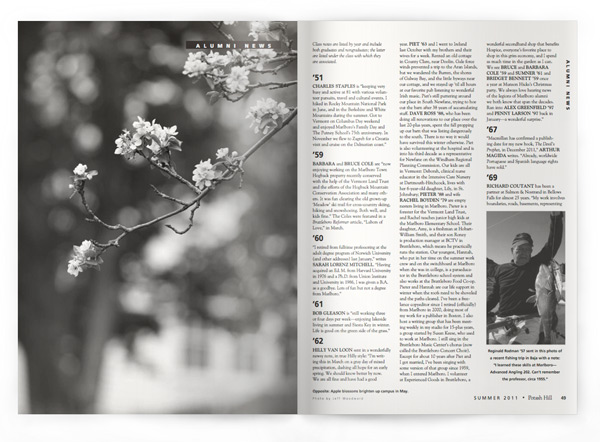
Class notes are listed by year and include both graduates and nongraduates; the latter are listed under the class with which they are associated.
’51
CHARLES STAPLES is “keeping very busy and active at 81 with various volunteer pursuits, travel and cultural events. I hiked in Rocky Mountain National Park in June, and in the Berkshire and White Mountains during the summer. Got to Vermont on Columbus Day weekend and enjoyed Marlboro’s Family Day and The Putney School’s 75th anniversary. In November we flew to Zagreb for a Croatia visit and cruise on the Dalmatian coast.”
’59
Barbara and Bruce Cole are “now enjoying working on the Marlboro Town Hogback property recently conserved with the help of the Vermont Land Trust and the efforts of the Hogback Mountain Conservation Association and many others. It was fun clearing the old grown-up ‘Meadow’ ski trail for cross-country skiing, hiking and snowshoeing. Both well, and kids fine.” The Coles were featured in a Brattleboro Reformer article, “Labors of Love,” in March.
’60
“I retired from fulltime professoring at the adult degree program of Norwich University (and other addresses) last January,” writes Sarah Lorenz MitchelL. “Having acquired an Ed. M. from Harvard University in 1976 and a Ph.D. from Union Institute and University in 1986, I was given a B.A. as a goodbye. Lots of fun but not a degree from Marlboro.”
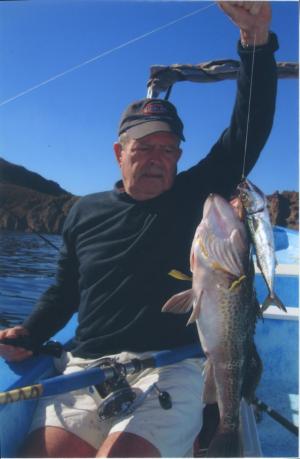 ’61
’61
BOB GLEASON is “still working three or four days per week—enjoying lakeside living in summer and Siesta Key in winter. Life is good on the green side of the grass.”
’62
HILLY VAN LOON sent in a wonderfully newsy note, in true Hilly style: “I’m writing this in March on a gray day of mixed precipitation, dashing all hope for an early spring. We should know better by now. We are all fine and have had a good year. PIET ’63 and I went to Ireland last October with my brothers and their wives for a week. Rented an old cottage in County Clare, near Doolin. Gale force winds prevented a trip to the Aran Islands, but we wandered the Burren, the shores of Galway Bay, and the little byways near our cottage, and we stayed up ’til all hours at our favorite pub listening to wonderful Irish music. Piet’s still puttering around our place in South Newfane, trying to hoe out the barn after 38 years of accumulating stuff. DAVE ROSS ’88, who has been doing all renovations to our place over the last 20-plus years, spent the fall propping up our barn that was listing dangerously to the south. There is no way it would have survived this winter otherwise. Piet is also volunteering at the hospital and is into his third decade as a representative for Newfane on the Windham Regional Planning Commission. Our kids are all in Vermont: Deborah, clinical nurse educator in the Intensive Care Nursery at Dartmouth-Hitchcock, lives with her 6-year-old daughter, Lily, in St. Johnsbury; PIETER ’88 and wife RACHEL BOYDEN ’79 are empty nesters living in Marlboro. Pieter is a forester for the Vermont Land Trust, and Rachel teaches junior high kids at the Marlboro Elementary School. Their daughter, Amy, is a freshman at Hobart-William Smith, and their son Roney is production manager at BCTV in Brattleboro, which means he practically runs the station. Our youngest, Hannah, who put in her time on the summer work crew and on the switchboard at Marlboro when she was in college, is a paraeducator in the Brattleboro school system and also works at the Brattleboro Food Co-op. Pieter and Hannah are our life support in winter when the roofs need to be shoveled and the paths cleared. I’ve been a freelance copyeditor since I retired (officially) from Marlboro in 2000, doing most of my work for a publisher in Boston. I also host a writing group that has been meeting weekly in my studio for 15-plus years, a group started by Susan Keese, who used to work at Marlboro. I still sing in the Brattleboro Music Center’s chorus (now called the Brattleboro Concert Choir). Except for about 10 years after Piet and I got married, I’ve been singing with some version of that group since 1959, when I entered Marlboro. I volunteer at Experienced Goods in Brattleboro, a wonderful secondhand shop that benefits Hospice, everyone’s favorite place to shop in this grim economy, and I spend as much time in the garden as I can. We see BRUCE and BARBARA COLE ’59 and SUMNER ’61 and BRIDGET BENNETT ’59 once a year at Munson Hicks’s Christmas party. We always love hearing news of the legions of Marlboro alumni we both know that span the decades. Ran into ALEX GREENFIELD ’97 and PENNY LARSON ’97 back in January—a wonderful surprise.”
’67
“Macmillan has confirmed a publishing date for my new book, The Devil’s Prophet, in December 2011,” ARTHUR MAGIDA writes. “Already, worldwide Portuguese and Spanish language rights have sold.”
’69
RICHARD COUTANT has been a partner at Salmon & Nostrand in Bellows Falls for almost 25 years. “My work involves boundaries, roads, basements, representing towns, commercial businesses, divorces. Beats plucking chickens.”
LISA INGELFINGER HARRIS recently moved to Rhode Island to be closer to the ocean and her grandchildren. She continues to work as a ceramic artist.
Memorabilia: Hoop Dreams
by Shelly Klapper ’69
We were sitting in the clubhouse of Satan’s Grazers, Marlboro’s vegetarian motorcycle gang, when Tom Ragle came in and told us that the college association’s accreditation committee was visiting campus that afternoon. Marlboro was in the final stages of getting its first accreditation, and at first we thought he was going to ask us to leave campus for a few hours. But instead he told us that a college had to have an athletic facility to be accredited, and although so many of us skied, or at least regularly tobogganed in the middle of the night, these activities would not count.
He wanted us to go down to Persons, the Music Festival concert hall with the asphalt floor, and be there playing basketball at two that afternoon, when he would show the accreditation committee in to view what would be, so obvious to anybody, Marlboro’s completely wonderful, required athletic facility. He had gotten Don Woodard, the maintenance and more guy, to build a backboard. So we went down, Sandy Williams, the Stafford brothers (not a country band), Eugene Zuckoff, Rich Ross and a couple of others, some of whom actually knew what they were doing. We turned all the lights on and played, extremely frenetically, as there was no heat in the building and it was about eight degrees out (and in), and we couldn’t exactly play with coats and gloves on, because that wouldn’t look good at all. We played for at least 50 minutes (it felt like a week), periodically looking back at the door, until they finally showed up. They stood at the entrance talking for maybe 60 seconds or so, nodded and smiled to each other, and left. We immediately collapsed—completely exhausted. Apparently they were able to check off the last box on the list, and Marlboro was accredited.
’71
FRED GRAY has retired, as of June 2010. “Working on the house here in Marlboro, travelling and catching up on all the stuff I didn’t have time for during 15 years of teaching and administrating at The Putney School. Had a fantastic time with TOM TUCKER and family in Oregon in August 2009.”
’72
DENA DAVIS has accepted the Presidential Endowed Chair in Health/Humanities at Lehigh University in Bethlehem, Pennsylvania. “I will teach bioethics courses to undergrads and act as a catalyst for interdisciplinary health-related activities on campus. Quite a change, after 21 years in a law school. I am looking forward to alumni activities in Philadelphia and New York City.” Dena joined the board of trustees in May 2011.
QUITA DAVIS is “still working at Dartmouth College as the coordinator for the student activities center. In February, I became a grandmother. Life is grand.”
“RUTH MOSKOWITZ ’75 is one of my dear old Marlboro friends and original fellow New Yorker,” ELLIOT GERTEL writes. “She has always had one of the biggest, brightest and most cheerful smiles of anyone I know, with big, bright eyes and a personality to match. It was great to see her, ALICE GROSSMAN ’73, ELLEN SCHÖN ’75 and other Boston-area Marlboro friends at a mini-reunion at her lovely place at the beginning of last year. She made us a wonderful dinner. I’m still loving living and working in Ann Arbor and the University of Michigan and still would love to hear from old friends, who are always welcome guests. Got together with ROD LEON ’73, who lives outside Detroit, a couple of years back and hope to see him again before too many more years pass.”
’73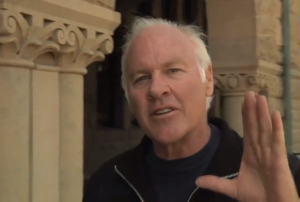 MARC SILBER has been making videos of top photographers (from Annie Leibovitz to Ansel Adams) at work. Check them out on the Advancing Your Photography with Marc Silber website at www.silberstudios.tv/episodes. “We just won two Telly awards,” says Marc.
MARC SILBER has been making videos of top photographers (from Annie Leibovitz to Ansel Adams) at work. Check them out on the Advancing Your Photography with Marc Silber website at www.silberstudios.tv/episodes. “We just won two Telly awards,” says Marc.
’75
“This past year has been an exciting one for me, with artist residencies in Finland, Hungary and Turkey,” ELLEN SCHÖN reports. “Since then, I have been energetically making new clay pieces, inspired in part by my travels.” Her work was exhibited at the Thayer Gallery in Braintree, Massachusetts, in January.
’76
As a field naturalist, educator and photographer, CHERRIE COREY helps to inspire others to seek their sense of place in the Concord, New Hampshire, landscape. She is a long-time Concord resident with a special affection for the area’s bogs and wetlands. Cherrie served as the New England Wildflower Society’s first education director, executive director of the Harvard Museums of Cultural and Natural History, and now delights in sharing her experience and following her muse as a consultant. Since her teens, photography has been a passion. Through the lens, she shares many wondrous wild moments for which there are no words.
’77
KEVIN McCAMANT writes, “Two kids at Marlboro (EMMA starting and IAN soon to finish up) brought me back to the Hill and surrounds. They make me wish I could go back and do it all again. Empty nesting is not too bad, though, although it does seem real quiet after school breaks, when the kids and all their friends leave. Saw some folks at LINDY WHITON’s photography show back in March: Annie Quest ’80, Matt Skeele ’79, Richard Witty, Diane Kazar WORTH ’80. Very cool. What a bunch we were/are. Sad to hear about TOM DURGIN ’79. All three of my original cottage-mates (Barb Brassor ’79, Nanda Fleming ’76 and Tom) are now gone. Still doing the forensic psychology thing both privately and for the state of Maryland. Also continue studying jazz guitar and resumed Zen Buddhist practice after a 20-year hiatus.”
LINDY WHITON had a “successful gallery showing of photographs from my 365-day Project of 2010 entitled ‘Edges’ in March. In 2010, knowing that my mother, Jean, would soon die, I decided to intentionally document the year by taking pictures every day. I took over 10,000 photos. Many of them were posted on Flickr and my blog, woanl.blogspot.com. The show was made up of 50 of these images. A clear message reflected in the pictures was that life weaves together from all of its parts, and for me Marlboro is one of the strands on the loom. The opening party was wonderful, with many Marlboro alumni in attendance. Now I’m working on a couple of new Projects—this photography thing makes me happy.
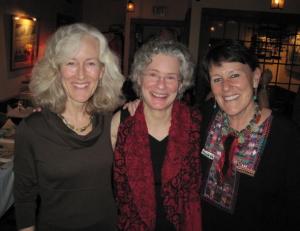 ’78
’78
In mid-March, Reggie Blaszczyk became a visiting fellow at the German Historical Institute in Washington, D.C., where she is working on a new history of Madison Avenue and its transnational connections in the Mad Men era. She spent early March as a visiting professor in the Centre for Fashion Studies at Stockholm University and late February as a visiting scholar at the Harry Ransom Center at the University of Texas Austin, where she was conducting research for an upcoming exhibit on the industrial designer Norman Bel Geddes.
Kimberly Cloutier Green writes, “I was saddened to hear about TOM DURGIN’s sudden death. I had not seen him in years, but my husband, Douglas, and our close friend PETE STEWART ’77 ran into him on a hiking trip in the Pemigewasset Wilderness a few years ago. They spent the evening together around a campfire. I remember Tom with great affection—his sweet sense of humor, deep care for authentic human connection, appreciation for the woods and easy, natural friendship. Tom seemed somehow beyond all the usual 20-something posturing during those long-ago Marlboro days. I keep close my sense of gratitude for having known this good man, and my sympathy goes out to all of his loved ones.”
’79
College bookstore manager BECKY BARTLETT says, “I can’t believe I’ve worked at the college for 10 years now. Time flies. My daughter Helga was 9 when I came (back) and she turned 20 today, hoping to transfer in the fall from Greenfield Community College to an art school. Meanwhile, my mom has moved to Brattleboro to relive the snows of her New England youth. My husband, Paul, is still painting houses—some for the second or third time—and Frisky the cat is still crazy after all these years.”
JAY DAVIS was married on his birthday, May 9, 2010, to Helen Leah Krasnow, who one week later received her master’s degree in nursing from University of Southern Maine. Jay and Helen are residing in Portland, Maine.
“Shortly after Marlboro, I moved down to Maryland and now live with my husband and teenage son outside of Annapolis,” LARISA PASTUCHIV-MARTIN writes. “I work at the Library of Congress, in the visual arts department of the U.S. Copyright Office, registering artwork and speaking at art conventions about copyright registration and protection. So, all you artists/photographers out there, I hope you put that copyright notice on your materials when you sell or publish. (If you have questions about copyright, you can email inquiries to copyinfo@loc.gov, and put my name in the subject if you wanted to ask me directly.) I’ve been doing wall murals in homes as a whimsical hobby, 3-D effects and trompe l’oeil architectural features. As a sideline I have continued playing bandura professionally and perform at fundraisers, showcase events for the Ukrainian Embassy and at the Smithsonian. I recently released a CD of my music entitled Dreaming (some of the pieces were written at Marlboro as composition assignments for Blanche), available for purchase or download at www.cdbaby.com.”
CHRIS NOTH appeared in the play That Championship Season, by Jason Miller, at the Bernard B. Jacobs Theater in New York this spring.
“I’m writing this from our barn in Putney, Vermont,” says NORM PARADIS, “but still live in California and spend most of my time shuttling around on airplanes trying to do biotech. Mostly working on hypothermia as a treatment for heart attacks, but have also gotten funded to investigate optical biosensors for shock. Occasional days as an actual doctor at USC in East Los Angeles. Our biomedical accelerator, Adoneh LLC, is doing well. It’s based in Boston, so one way or another we’ll get back to New England soon.”
DAN TOOMEY reflected on Marlboro’s profound impact on his father, William Toomey ’53, who passed away in April: “Just as he had tremendous respect for the faculty’s intelligence and commitment to teaching, he had tremendous admiration for his fellow students’ resourceful ingenuity, be it parking a Model A car over a trench filled with fresh manure to keep its engine warm overnight, or loosening the earth of what was to become the Fire Pond with dynamite charges. His memory for things Marlboro was seemingly infinite; well into old age, he could recount the jokes Roland told during his senior oral exams, who lived in which rooms in Mather, and what he learned about plant life and geology on Olive MacArthur’s field trips.”
RICHARD WITTY has opened an accounting practice with office hours in Brattleboro and Greenfield, where he works on “tax returns, tax planning, financial statement preparation, review and audits, personal financial planning facilitation and sustainability auditing from a couple methodologies. My oldest son is studying to be an ultra-orthodox rabbi, currently at a yeshiva in Paris. My younger son plays keyboards for the band Mountain Interval and released his first CD in March.”
’80
“Twenty years into binational marriage and the expat life in Spain,” CARY BARNEY writes, “I continue to teach theater and writing, and direct half the plays at Saint Louis University’s smaller-than-Marlboro (but much more crowded) Madrid campus. I recently taught a graduate-level playwriting class, and am currently directing a student-written, full-length play, all of which has me thinking I should take another whack at it myself sometime. Our son Sam is going on 14 and is doing a lot of writing himself. In early January, FEDERICO MUCHNIK ’81 was in town, and we got together for coffee and conversation. It was great seeing him again. Do drop in if you’re in the nabe.”
SOPHIE BLACK’s poem “Given Pornography” was published in an April edition of The New Yorker. She was also published in the March-April edition of American Poetry Review.
“I continue to make inroads to acting—talk about your late bloomers,” LORI KIRSTEIN said. “I was invited to audition for America’s Got Talent, which I did, shaking all the way. And I made my NBC debut last year on Trauma, for the first time qualifying for residuals as the result of an afternoon throwing a man out of a wheelchair; you have to love acting, don’t you? I am also a professional speaker and living out louder and louder the further over 50 I get. Who knew?”
 LUCY LOOMIS writes, “In addition to the mini-Marlboro reunion that was held at my house last fall (see Potash Hill, Winter 2011), I’ve been excited to connect with fellow Marlboro grads around photography. I was the featured photographer of the week on Boston.com’s RAW photo site in July and I currently write a weekly photo blog: littlelightreading.blogspot.com. LINDY WHITON ’77 and I both completed 365-day photo Projects in 2010 (hers is at woanl.blogspot.com and mine is at eleganceofwords.blogspot.com). I’ve loved seeing MARK MANLEY’s amazing documentary and fine art photography, and enjoying the Zen-like beauty of DIANNA NOYES’ photos on Facebook. And TONY SAVOIE ’81, HIRO WATANABE ’82, LORI KIRSTEIN and RICHARD COUTANT ’69 had us all having Marlboro flashbacks with the incredible photographs of Marlboro in the 1970s and early ’80s that they posted on Facebook.”
LUCY LOOMIS writes, “In addition to the mini-Marlboro reunion that was held at my house last fall (see Potash Hill, Winter 2011), I’ve been excited to connect with fellow Marlboro grads around photography. I was the featured photographer of the week on Boston.com’s RAW photo site in July and I currently write a weekly photo blog: littlelightreading.blogspot.com. LINDY WHITON ’77 and I both completed 365-day photo Projects in 2010 (hers is at woanl.blogspot.com and mine is at eleganceofwords.blogspot.com). I’ve loved seeing MARK MANLEY’s amazing documentary and fine art photography, and enjoying the Zen-like beauty of DIANNA NOYES’ photos on Facebook. And TONY SAVOIE ’81, HIRO WATANABE ’82, LORI KIRSTEIN and RICHARD COUTANT ’69 had us all having Marlboro flashbacks with the incredible photographs of Marlboro in the 1970s and early ’80s that they posted on Facebook.”
“Still in New York City, trying to survive as a photographer,” MARK MANLEY writes. “HOLLY WATERBURY MANLEY ’82 is living and working in Provincetown on the Cape and I’m holding it down here in the city (some people have ‘bi-coastal’ relationships; we are ‘uni-coastal’). This winter I was part of a collaborative Project with close friend and playwright Amy Hartman, a social service agency and the Luna Stage Company in West Orange, New Jersey, to build a program addressing gang violence among at-risk youth. I shot and wrote a photo essay, and Amy wrote a play that was followed by audience ‘talk backs’ and a playwriting workshop for high school students. You can learn more about it at my website: www.markmanleyphotography.com. In June, my work will be shown at the Zimmerli Museum of Art in New Brunswick, New Jersey, as part of an exhibition of current and former Johnson & Johnson/International Center of Photography Fellows, of which I was one back in 2007. Have been reconnecting with a lot of Marlboro folks through the miracle/curse that is Facebook—the reconnecting part has been great. Best to all.”
CAROLE CROMPTON MOODY writes, “Willow is now living in Costa Rica with her partner, Morgan, and their 1.5-year-old son, Roclin. She just turned 41. MAUREEN TADLOCK and I are having the most fun being Grandma and Grammy to Lila, who will turn 4 in May.”
DIANNA NOYES “had a nice phone conversation with LEE J. HOWARD in late March. He’s in Roswell, Georgia, where the mayor recently appointed him chairman of the Cultural Arts Board and where he recently ran his first half-marathon (he’s planning for a full one in the future). He’s still enjoying his business providing music for events. Lee J. and his ‘totally amazing’ wife of 24 years, Valorie, have a daughter, Marissa, who’s a senior at Georgia State studying dance therapy and working with autistic children. As for me, I’m still loving being at the college—the students never cease to inspire and amaze me. Max and I traveled to the Florida panhandle for the requisite ‘get out of Vermont in March’ trip, and I pushed the boundaries of my comfort zone by kayaking in an alligator-inhabited cypress swamp and eating okra.”
CARTER SIO says, “OK, so we will start with the youngest, Emma, 14, who will be coming to George School next fall. She continues to tear up the dance floor in Irish dance competitions up and down the east coast. She also loves horseback riding, singing, acting and working in soup kitchens. Dylan, 20, is at home this year, going to the community college, studying business and working two part-time jobs: making subs at the local sub shop and washing hair at a high-end beauty parlor. Yep, he loves that second one. He continues to have the ‘no fear’ gene and is an avid long-boarder, bombing hills and videotaping the ride just to terrorize his parents later. He hopes to transfer to Drexel or Temple next spring. Erin is adjusting to a new job, that of ‘the’ science teacher at Greene Street Friends in Philadelphia. She and Emma will be spending three weeks in China this summer doing service. This is my 28th year of teaching at George School, and I still love it. My students just exhibited their work at the Philadelphia Furniture Show and received all kinds of accolades for being so young and showing work at a national show. I was very proud of them. I’m currently working on a podium that is a commission piece. I will also be heading to Asia this summer, to Vietnam for two weeks to do service alongside students from my school. Then, of course, to the coast of Maine for the remainder of the summer. Spent the Super Bowl with MARK MANLEY, and all I can say is, that man still knows how to party.”
“Good news,” STEVE SMITH reports. “I am scheduled to be married on May 15 to Debra Yarrington, here in Delaware. Otherwise, the same old. I write for a number of media trade magazines, consult with companies on the digital transition and each year I program/host about a dozen conferences and executive summits around the U.S. on digital media, mobile platforms and advertising. Looking forward to resuming married life and spending less time on planes and trains. I love New York, San Francisco and Los Angeles (well, not really L.A.), but enough is enough.”
DIANE KAZAR WORTH has been teaching adult immigrants in Greenfield, Massachusetts, for the past 10 years. “Prior to that I was teaching English in Kyoto at various universities for nine years. Very rewarding work. I’ve been a printmaker for over 20 years and am a member of Zea Mays Printmaking, where we practice with low/non-toxic materials. I’m married with two kids: Tucker is 22 and an excellent classical guitarist, Emma is 10 and is an avid reader and artist. We also have a Lab, a cat, a parrot, three chickens and a duck. The days are very busy. Looking to sell our house in Northfield—nice creek in the backyard, anyone interested?”
Mark Genszler Moves On to Another Flock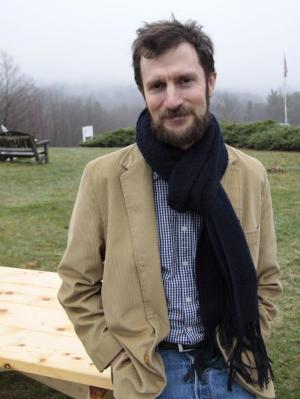 Marlboro’s alumni director since 2007, Mark Genszler ’95 left at the end of June to pursue a wonderful new opportunity. He is off to New York City in the fall to study at General Theological Seminary, an Episcopal divinity school in Chelsea. The program is for a Master of Divinity (M.Div.), the degree most people pursue before becoming a priest in the Episcopal Church.
Marlboro’s alumni director since 2007, Mark Genszler ’95 left at the end of June to pursue a wonderful new opportunity. He is off to New York City in the fall to study at General Theological Seminary, an Episcopal divinity school in Chelsea. The program is for a Master of Divinity (M.Div.), the degree most people pursue before becoming a priest in the Episcopal Church.
“I’ll be back to southern Vermont—so close, really—as often as time and schedule allow, and welcome visitors in New York,” said Mark. “I think August will find me on a long bicycle trip. These past four and a half years have been a wonderful time, and I am grateful for my various colleagues—staff, faculty, alumni volunteers and students.”
Mark has accomplished many things during his time here, most notably supporting the establishment of a new alumni council and a revitalized alumni association, helping to create more formal alumni networks for the new career development office and recruiting alumni volunteers for the admissions office.
’81
“I am working in the trenches with patients with post-acute traumatic brain injuries while rescuing and fostering animals on the side,” NERINGA PERMINAS ATKISON writes.
ERSZI DEÁK is “still in Paris, where I’ve lived for the last 25 years. In November I launched Hen & Ink (henandink.com), a literary studio, with the sale of Dear Dylan and Finding Cherokee Brown, by Siobhan Curham. The agency continues to grow, and I look forward to exploring transmedia possibilities as well as traditional publishing for my clients. It’s all happened incredibly fast, and my submissions list makes me feel sufficiently guilty when I take a break along the Seine with our dog, Bingley. Our three girls are on their own journeys: Elisabeth, 21, hopes to return to London for school in the fall; Nelly, 19, is deep in philosophy at McGill in Montreal; Esmee, 15, is now studying for her American high school diploma via a correspondence program out of the University of Nebraska, and thriving. My husband, Charles, is exploring wood carving and relocating those of us left in Paris to the South of France. And I’m still writing in between all of the above.”
“Marlboro was one of the fondest times for me and still feeds me with idealism, creativity and joy,” writes CHRIS HOLDHUSEN. “Never did become a good writer, musician or artist despite all the effort. Have been through interesting times recently, helping form and direct a community health center here in the Flathead Valley of Montana—I am a
physician. Mainly a family guy, married 18 years to Kathy, with three kids (all outdo me), and have a condition I call ski rabies. Hope to survive unscathed.
“After three years with Chicago Public Radio, dumped because either they lost the stomach for my R&D or I lacked the talent and skill to pull it off,” LLOYD KING writes. “I took a day gig as career counselor in the arts with the University of Chicago. Love the gig, and get to keep the Chicago moniker. Still playing sax and flute with Funkadesi. More in love with BETH TYLER ’83 than ever. Marlboro people rule.”
TRICIA LOWREY LIPPERT is “still living in Pennsylvania. I’ve been working at the animal hospital almost 10 years now. I also bake all the desserts and vegan specials for the Ship Inn, an English brewpub in Milford, New Jersey, where my husband is the chef. I paint and show my work in the area and am part of a plein-air group called ‘Come Paint with Me.’ I’m also pretty active with my local arts council. Last spring I drove out to Ohio and saw JOHN GILLIOM ’82 and AMY KING ’82 on their farm. It’s a beautiful place, and they both looked great!”
’82
“I’m starting my own business as a kitchen and bath designer,” LESLIE REESE BROWN writes. “Met Ellen, Marlboro’s wonderful president, in Boulder with some parents of current students. Their kids went to my son’s high school. My son, Alexander, is looking at Marlboro as a college choice. How weird and wonderful is that? Love to all.”
KATHARINE JUDD is “somewhere in the middle of my studies to become a Chazzanit (female cantor) at Hebrew College in Newton, Massachusetts. Hebrew College resembles Marlboro in its smallness, shoestring budget, great teacher-student ratio and deep commitment to a high-quality learning experience. Thank God such places persist.”
This spring, DANIEL PICKER had his poems published in Rune, the MIT journal of arts and letters, for the fifth straight year.
Pieter van Loon ’88: Conserving Vermont forests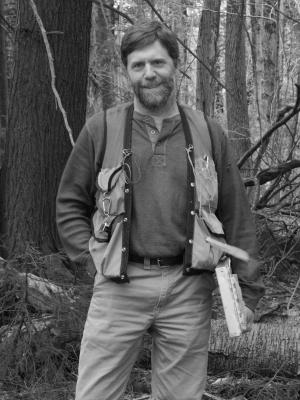 “Few enough people know what a forester does; if you tell them you are a stewardship forester working for a land trust, their eyes just glaze over,” said Pieter van Loon, who works for the Vermont Land Trust all across the southern half of the state. “I most enjoy meeting with landowners and helping them come to realize all the wonderful things that exist on their properties beyond the obvious, the trees. If you are going to manage a forest, you have to know about all its parts: the shrubs, the herbs, the animals, the natural communities, the wildlife habitat.”
“Few enough people know what a forester does; if you tell them you are a stewardship forester working for a land trust, their eyes just glaze over,” said Pieter van Loon, who works for the Vermont Land Trust all across the southern half of the state. “I most enjoy meeting with landowners and helping them come to realize all the wonderful things that exist on their properties beyond the obvious, the trees. If you are going to manage a forest, you have to know about all its parts: the shrubs, the herbs, the animals, the natural communities, the wildlife habitat.”
Pieter is called in whenever there is a forestry-related issue on any VLT-conserved property, from the rich northern hardwood and warm oak communities of the Taconics to the high-elevation spruce and birch on the spine of the Green Mountains. He loves getting to traverse Vermont: “There are still new and wonderful places to see and discover, there are just fewer of them now that I have been traveling the state for 11 years.” After studying forestry at Marlboro and working in the field ever since, he thinks one of the most important things Marlboro did for him was instill a curiosity for learning and a comfort in addressing subjects outside of his formal training. “Those are the skills I use every day.”
’83
Ben Sargent ’83 and Mary Lin ’87 (nee Iacobucci) are writing their second opera together, which is also their second commission, and working to get the first opera produced.
“I’m very happy that Vermont has elected another governor from Putney, Peter Shumlin,” Xenia S. Williams writes. “George Aiken was from Putney; Peter has large shoes to fill. Retired now by poor health (arthritis), I continue to advocate at the Vermont legislature for disability rights.”
’85
Nevada “Nikki” Bromley is “directing students in a production of Broth at Landmark College, in Putney. Broth is a comedic drama I’ve written about a mishmosh of characters who inhabit a boarding house in a New England coastal town in the late 1960s. After testing it out in production, and fixing it up, I’ll seek out a publisher. I’m fortunate to have a great editor, my son Arden, who is living and working in New York City. Thanks go out to my Marlboro theater professor, Geoffry Brown.”
“Still loving working in New York City as a wound care nurse, after a year as a hospice nurse,” Monika MacLean Lyman writes. “I love reconnecting with old friends, so feel free to drop me a line at Monika.Lyman@gmail.com.”
JEFF POWELL is “still working at ‘Aunt Lucy’ (Alcatel-Lucent, Ma Bell’s little half sister), which is a triumph unto itself. Our son Ko is 15 and a freshman at ConVal High in Peterborough. He is truly a remarkable guy—playing upright bass in the concert band, guitar with the jazz band, electric bass, rock guitar and STILL studying classical guitar. Between him and me, we have four basses and I have no idea how many guitars.”
’86
“With myself, PETER ‘Chanman’ CHANDLER ’85, GREG MEYERS ’08 and SAM LOWENTHAL ’09 living here, Jackson Hole probably has the highest density of Marlboro graduates any place west of Brattleboro,” writes MARKUS BRAKHAN. “On Saturdays, I see Chan singing in his Tram Jam ensemble at the base of the gondola, Greg loading the gondy and Sam bumping chairs on Thunder. As I frequently remind kids, it’s good to get college out of the way so you can be a ski bum for the rest of your life. It’s been a great winter—over 500 inches of snow with a week to go.”
Chris Blackwell ’90: Digitizing ancient texts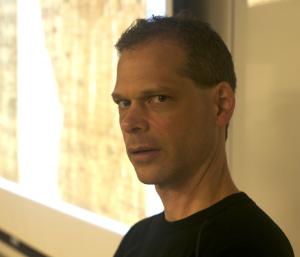 As a classics student at Marlboro, Chris Blackwell focused on the possibilities for interpreting history using primary sources of ancient literature. Now a classics professor at Furman University, Chris and his students are examining meticulously hand-written manuscripts that are about as “primary” as it gets. He recently received a grant from the National Science Foundation to analyze some of the oldest written documents in the Western world.
As a classics student at Marlboro, Chris Blackwell focused on the possibilities for interpreting history using primary sources of ancient literature. Now a classics professor at Furman University, Chris and his students are examining meticulously hand-written manuscripts that are about as “primary” as it gets. He recently received a grant from the National Science Foundation to analyze some of the oldest written documents in the Western world.
The $100,000 grant will give Chris an opportunity to use new digital technology to identify and transcribe the handwriting of scribes from ancient Greece. “This work is intensely collaborative, and it lends itself ideally to collaboration between middle-aged professor types like me and undergraduates like the brilliant young people I get to teach at Furman,” said Chris. He and his students will focus on two texts purported by scholars to be written by the same scribe: the sole surviving copy of Aristotle’s treatise on the history and function of the Athenian democracy and the only surviving fragment of a song by the poet Alcman, one of the few pieces of literature in existence from ancient Sparta. “If my collaborators and I never leave our offices again, we have a century of discoveries to be made with our students based merely on the images I now carry around on my iPad.”
’91
“Hello to all,” writes AMY KOCH. “After over 10 and a half years in Japan, I am currently in Wisconsin. That may change (might have by press time, actually) due to the labor situation. I am a bilingual (Spanish) teacher with the public school system, and since Wisconsin’s governor thinks we are expendable, I might have to pack my bags again. Attending protest rallies in Madison has been uplifting, however. A highlight one cold, snowy Saturday in late February was singing ‘Blowin’ in the Wind’ with Peter Yarrow and the rest of the 100,000 people there. I would love to hear from old friends. Email me at a.koch@care2.com. Consider yourselves hugged.”
’92
PETER BLANCHETTE was a co-winner in the Outstanding Individual category of WFCR’s 2011 Arts and Humanities Award this spring. Peter, inventor of the 11-string arch guitar and founder of the Happy Valley Guitar Orchestra, was recognized for his commitment to the arts in the Pioneer Valley of Massachusetts. He shared the honor with Stephen Hays, executive director of the Drama Studio and founder of Stage West.
“The solar power world continues to grow more rapidly than nearly any other industry in the nation, doubling every two years or so. It is keeping us very busy,” JEFF BOWER writes. “Our company installed the world’s largest solar array last year (72 megawatts on the ground in Italy), and in the U.S. we continue to narrow the gap between the installed solar cost and the subsidized grid cost; it’s been a long battle, but we gain ground each day. I very much enjoyed the 2011 EPA Energy Star awards this year, cheering on several of our customers who won. Life in Marlboro is good; the garden has begun, we’re dusting off the bikes and the kayaks, and I am exhibiting another painting at the Southern Vermont Art Center’s annual members’ show. Don’t forget to join us September 10 for the town fair, celebrating Marlboro town’s 250th anniversary.”
JAKE DALTON and ALICE ROBINSON ’98 are married and living in Berkeley, California, with their 6-year-old twin girls, Isla and Naima. Jake is a professor of Tibetan Buddhism at U.C. Berkeley and Alice does training and education in the field of social work. Jake just received a Ryzcamp Fellowship and will be doing research next year in London and at home.
“After 17 years in Tucson, Arizona, the family and I have moved to Boston,” Cristina Wigert Feeley writes. “We’re not enjoying the weather much, but it is good to be closer to Marlboro. Maybe now we’ll have some people come visit;
the door’s always open.”
Michael Crane ’92: Building ecotourism in Iraq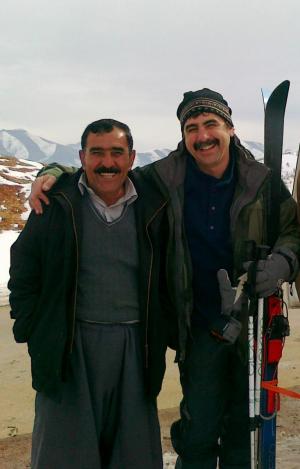 Until recently, urban planner and environmental economist Michael Crane was doing reconstruction work for the U.S. State Department in Tikrit, Iraq, Saddam Hussein’s home town. Now in Kurdistan, northern Iraq, Michael is trying to promote a positive image for environmental tourism in this region full of natural beauty.
Until recently, urban planner and environmental economist Michael Crane was doing reconstruction work for the U.S. State Department in Tikrit, Iraq, Saddam Hussein’s home town. Now in Kurdistan, northern Iraq, Michael is trying to promote a positive image for environmental tourism in this region full of natural beauty.
“Kurdistan is friendly; Kurdistan is welcoming; Kurdistan is ready for you,” said Michael. “We have hundreds of millions of acres of untouched wilderness, and it’s safe.” Though not a single American has been killed in Kurdistan since the beginning of the war in 2003, no part of Iraq has the level of political and economic stability to harbor real ecotourism in the near future. “They need a political environment to ensure that decisions about the commons are made communally. They need a governance structure that implements plans, and a public administration that can manage efficiently.” Michael’s work in ecotourism is thus fully integrated with other kinds of development planning and capacity-building for the government.
Nearly 20 years after graduation, Michael says Plan sponsors Jim Tober and Jenny Ramstetter are always somewhere in the back of his mind. His Plan was an investigation of how to sustainably manage natural resources to benefit both long-term protection and present needs for community development. “I am still working on finding that balance every day.”
’93
RANDY GEORGE says, “Come visit me at Red Hen Bakery and Café in Middlesex, Vermont, just off exit 9. It’s been great seeing Joe Mazur, MARK GENSZLER ’95, Carol Hendrickson and her class, DIANNA NOYES ’80, Jerry Levy, TIM LITTLE ’65 and others lately.”
’94
GINA DEANGELIS and ALEX GREENFIELD ’97 were among six finalists (out of 2,700 entrants) in the Amazon Studios “Best Script” contest in January. Alex is currently a writer and producer working on a reality TV pilot. Gina, an editor/writer at Colonial Williamsburg and a regional Emmy winner, wrote, “how incredibly odd this is—two people from the same tiny, tiny school in Vermont, both finalists in this contest something like 18 years later. Moreover, Marlboro had no film or screenwriting classes or professors at all when we were both there.”
’95
“Hello,” say CAROLYN STEPANEK ROSS and Edward Ross ’96. “It has been a little while since we last sent news. All is well. We are still living near Boston. The girls are now 13, 11 and 9 years old. Carolyn is still working on the registry of deeds and doing fiber arts, like spinning, in her free time. Edward is homeschooling the girls and reads a great deal in his free time.”
’96
RICH BOULET sends this: “I have some Marlborian news for Potash Hill: CULLEN SCHNEIDER ’04, who owns Fairwinds Florist, right around the corner from Blue Hill Public Library [where Rich is the director, ed.], is now the president of the Blue Hill Peninsula Chamber of Commerce. You heard it here first. Also, her younger sister, Thea, is a soon-to-be Marlboro graduate, and her even younger sister, Zoë, will attend in the fall. That’s a high concentration of Marlboro news from Blue Hill, Maine.”
ERIN PETERS is “on my first scripted show, Eastbound and Down, as night assistant editor. It will be on HBO this fall. It stars Danny McBride and is directed by David Gordon Green.”
’97
ALEX GREENFIELD and PENNY LARSON have moved back to Marlboro, from California. Alex is working as a screenwriter and shared the Best Table Read award from Amazon Studios this spring with director Christian Davis for his script Memory.
“Hello to my Marlboro friends,” WENDY LEVY says. “Email me if you’re coming to the New York City area: cheesesnobwendy@gmail.com. Let’s have tea and catch up.”
KELLY SNOWDON STOCKWELL is “doing well, busy with (almost) two jobs,
a day gig at Chroma and my side-line job as a bluegrass bassist. Our band, Hot Mustard, is getting busier and having a good time playing around New England—www.hotmustardbluegrass.com. Chroma is really busy right now—I travelled to Japan, Korea and Singapore visiting customers last year, and am headed to Munich this spring for a trade show. I really liked Japan; next trip there, we’re going to Kyoto.”
TINO FIERRO is “working at the United States Patent and Trademark Office in Alexandria, Virginia. Previously, worked three years as a cross-country adventure tour leader, and then four years as a corporate supervisor. Quit my job, took a couple of months off, doing contract work now, and leaving for Peace Corps service next year. I will send updates. Still have close friends from the Marlboro days, and still struggle when people ask me what I got a degree in. Theater? Philosophy? Psychology? I |just say ‘Aesthetics,’ and the subject changes.… Has there been a Camaro on campus since mine?”
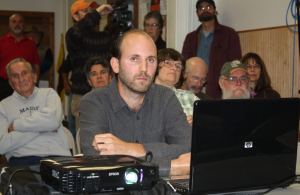 ’00
’00
JASON BUENING has this to say: “Squiggle.”
’01
In April, REBECCA SCHEIN interviewed Noam Chomsky on stage at Carleton University, on the subject of “democracy and the public university.” You can see the video at wwwl.carlton.ca/iis/news/noam-chomsky.
’02
Lauren Beigel MacArthur writes, “Jason MacArthur and I were married in July 2010, and we’re joyfully expecting our first child in January!” [ed. note: Lauren and Jason, and the rest of the MacArthur clan, welcomed Milo a bit early, on the full moon winter solstice in December.]
“Just wanted to share the news that I got a book deal with Penguin this week,” reports CLAIRE BIDWELL SMITH. “My memoir, The Rules of Inheritance, will come out in hardcover, spring of 2012. I really couldn’t be more thrilled.”
’03
EMILY AMANNA and DAVID HASSAN ’04 run Wild Shepherd Farm near Athens, Vermont. They raise vegetables, herbs and garlic—30,000 heads this year, according to the Brattleboro Reformer, who ran a story on the couple in April. Emily can often be found at the Brattleboro Farmers’ Market on Saturday mornings behind an array of gorgeous produce. They also raise sheep and cows for cheese and meat, and are planning to expand their herds. After leasing the farm for a number of years, the couple was able to purchase it this spring with help from Vermont Land Trust’s Farmland Access Program, “securing the land as a working farm for generations to come,” according to Emily.
ALLISON GAMMONS is “currently an M.Div. student at Bangor Theological Seminary (on the part-time, seven-year plan!), and continuing to enjoy my work as the director of religious education at First Parish Unitarian Universalist Church, right in downtown Portland, Maine. If any Marlboro alumni in the area ever want to come share their talents with the kids I’d welcome the volunteers.”
ULLA VÄLK visited campus in March, after travelling from her home in Amsterdam to New York for work. She is looking forward to the imminent publication of her new book, Pancakes for Breakfast (see Potash Hill, Winter 2011), which was delayed from its
original publication date.
’04
“After four years as an advocate for domestic violence survivors, I now train community members on issues of racism and oppression,” Choya Adkison-Stevens writes. “Portland, Oregon, feels more and more like home. Life is good.”
JOE FLOYD started a Ph.D. in history at Georgia State University in January.
ALAINA HAMMOND writes, “A play I wrote entitled Lips Upon Cheeks was included in the 2011 InGenius Festival this past January. Performed at Manhattan Theatre Source (off-off Broadway), the evening of plays received a positive review on nytheatre.com and was revived in February.”
MARC PILARO and Anita Britton became the proud parents of Hunter Griffin Pilaro on September 10, 2010.
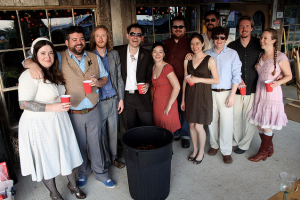 ‘05
‘05
SUE McCLINTOCK began a new position as the library director at the Vose Library in Union, Maine, in February. “I’m enjoying my job, and I’m so happy to be back in Maine. I’m looking forward to dancing, Habitat house-building, gearing up for National Novel Writing Month, making new friends and reconnecting with old ones. If you’re in the area, drop me a line or stop by and visit the library.”
SARAH MUTRUX is in Craftsbury Common, Vermont, where she works in Sterling College’s admissions office and co-manages The Common Place, a nonprofit arts organization whose mission is to “cultivate the creative and literary interests of youth and adults in the Northeast Kingdom while supporting the local economy.” Sarah is also a recent graduate of the Marlboro College Graduate School’s nonprofit management program.
ANTHONY SCHEIN writes, “I very much enjoyed having my sister REBECCA SCHEIN ’01 living in Toronto for much of the year. She has since moved to Ottawa, where she is assistant professor of human rights studies at Carleton University. In the fall, I managed my first political campaign in a local election here. The candidate was my oldest brother, and he finished a close second, with nearly 5,000 votes. We had great fun, and it was an incredible learning experience. 2010 also involved a career change: In December, I joined AMAPCEO (the Association of Management, Administrative and Professional Crown Employees of Ontario), the second-largest union representing Ontario public servants, as executive assistant to the president. I am enjoying working in politics at a different level of government and learning the labor relations field. My knowledge of governance and procedure from my Marlboro days comes in very handy. I think of life on the hill often, and look forward to a visit very soon.”
’07
LILLIAN SCHRANK was married to Forbes Graham, “a trumpet player (whom I met playing at Marlboro), on August 30, 2009. Please check out my art at www.LillianHelenGraham.com.”
MOSES SANDROF is working as a research assistant in a pathobiology lab at Brown University, studying the effects of commercial and industrial toxicants on the male reproductive system. He’s also applying to grad schools to further his studies in biology, “or moving to a farm. Or both.”
’08
“2010 was a busy year for me,” writes RAYNA MAYO. “I finished a master’s degree in environmental studies from the State University of New York, I got married in Boothbay Harbor, Maine, and I moved to Portland, Oregon. Currently I’m doing environmental lobbying in the state capitol for Oregon Environmental Council to ban BPA in children’s products. Portland is a really great city, but this has been my first winter without snow and I miss the impromptu sledding of Vermont.”
Katherine Partington ’09: See you in the movies “It was cool and weird,” said Katherine Partington, who won both the L.A. Movie Award and the Maverick Movie Award for Best Actress based on her role in the made-for-T.V. movie Overload last year. As her first major role in a feature film, this recognition reflected a great success for her as a new actress. “I worked very hard to give a solid performance, but winning an award for best actress went above and beyond,” she said.
“It was cool and weird,” said Katherine Partington, who won both the L.A. Movie Award and the Maverick Movie Award for Best Actress based on her role in the made-for-T.V. movie Overload last year. As her first major role in a feature film, this recognition reflected a great success for her as a new actress. “I worked very hard to give a solid performance, but winning an award for best actress went above and beyond,” she said.
Since graduating with a Plan in political science and dance, Katherine has been busy working in New York City at several jobs simultaneously, but primarily as a freelance performance artist for a variety of choreographers, directors and filmmakers. “In one week I will work as an intern, hostess, choreographer, dance teacher and performer,” she said.
Katherine is working with Robert Fritz, director of Overload, again this summer on another feature-length film. A Matter of Fact is the story of a recent journalism graduate—played by Katherine—on her first newspaper job in a rural Vermont town, and will be filmed in the Brattleboro area. Thrilled about the encouragement from her two awards, Katherine says, “I’m really excited to continue acting in films.”
’10
ALEC KOUMJIAN is the online business manager for ReCycle Away in Brattleboro, a company that sells recycling containers for public spaces.
SUSANNAH MOHAN and GENAM YESHI are living in Dharamsala, India, working at the Norbulingka Foundation for Tibetan refugees.
LISA ORENSTEIN is in the Peace Corps in Ukraine, teaching English as a Foreign Language. Besides the everyday challenges of a classroom of kids with “a lot of energy,” Lisa reports that she has felt very welcome in Kodyma. “Everyone says ‘hi’ on the street, and I am invited to lunch, dinner or tea almost every day.” See a profile of Lisa’s work in Ukraine in the new career development enewsletter, After Marlboro.
Letters
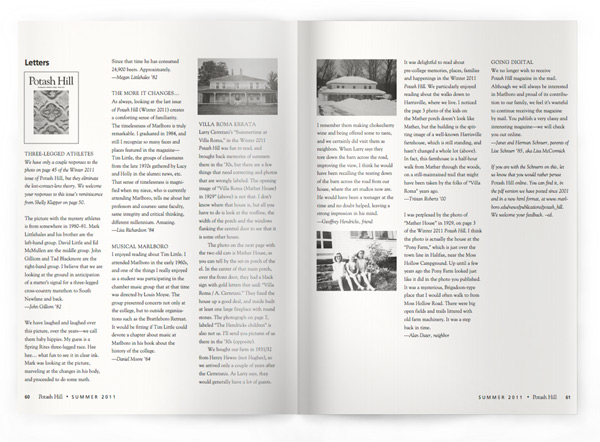
Three-Legged Athletes
We have only a couple responses to the photo on page 45 of the Winter 2011 issue of Potash Hill, but they eliminate the lost-contact-lens theory. We welcome your responses to this issue’s reminiscence from Shelly Klapper.
The picture with the mystery athletes is from somewhere in 1980–81. Mark Littlehales and his brother are the left-hand group. David Little and Ed McMullen are the middle group. John Gilliom and Tad Blackmore are the right-hand group. I believe that we are looking at the ground in anticipation of a starter’s signal for a three-legged cross-country marathon to South Newfane and back.
—John Gilliom ’82
We have laughed and laughed over this picture, over the years—we call them baby hippies. My guess is a Spring Rites three-legged race. Hee hee… what fun to see it in clear ink. Mark was looking at the picture, marveling at the changes in his body, and proceeded to do some math. Since that time he has consumed 24,900 beers. Approximately.
—Megan Littlehales ’82
The More It Changes…
As always, looking at the last issue of Potash Hill (Winter 2011) creates a comforting sense of familiarity. The timelessness of Marlboro is truly remarkable. I graduated in 1984, and still I recognize so many faces and places featured in the magazine—Tim Little, the groups of classmates from the late 1970s gathered by Lucy and Holly in the alumni news, etc. That sense of timelessness is magnified when my niece, who is currently attending Marlboro, tells me about her professors and courses: same faculty, same integrity and critical thinking, different millennium. Amazing.
—Lisa Richardson ’84
Musical Marlboro
I enjoyed reading about Tim Little. I attended Marlboro in the early 1960s, and one of the things I really enjoyed as a student was participating in the chamber music group that at that time was directed by Louis Moyse. The group presented concerts not only at the college, but to outside organizations such as the Brattleboro Retreat. It would be fitting if Tim Little could devote a chapter about music at Marlboro in his book about the history of the college.
—Daniel Moore ’64
Villa Roma Errata
Larry Cerretani’s “Summertime at Villa Roma,” in the Winter 2011 Potash Hill was fun to read, and brought back memories of summers there in the ’30s, but there are a few things that need correcting and photos that are wrongly labeled. The opening image of “Villa Roma (Mather House) in 1929” is not that. I don’t know where that house is, but all you have to do is look at the roofline, the width of the porch and the windows flanking the central door to see that it is some other house.
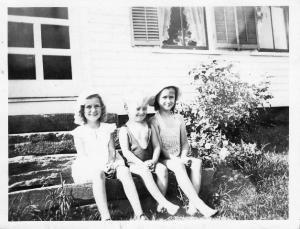 The photo on the next page with the two old cars is Mather House, as you can tell by the set-in porch of the el. In the center of that main porch, over the front door, they had a black sign with gold letters that said: “Villa Roma / A. Cerretani.” They fixed the house up a good deal, and inside built at least one large fireplace with round stones. The photograph on page 7, labeled “The Hendricks children” is also not us. I’ll send you pictures of us there in the ’30s.
The photo on the next page with the two old cars is Mather House, as you can tell by the set-in porch of the el. In the center of that main porch, over the front door, they had a black sign with gold letters that said: “Villa Roma / A. Cerretani.” They fixed the house up a good deal, and inside built at least one large fireplace with round stones. The photograph on page 7, labeled “The Hendricks children” is also not us. I’ll send you pictures of us there in the ’30s.
We bought our farm in 1931/32 from Henry Hewes (not Hughes), so we arrived only a couple of years after the Cerretanis. As Larry says, they would generally have a lot of guests. I remember them making chokecherry wine and being offered some to taste, and we certainly did visit them as neighbors. When Larry says they tore down the barn across the road, improving the view, I think he would have been recalling the tearing down of the barn across the road from our house, where the art studios now are. He would have been a teenager at the time and no doubt helped, leaving a strong impression in his mind.
—Geoffrey Hendricks, friend
It was delightful to read about pre-college memories, places, families and happenings in the Winter 2011 Potash Hill. We particularly enjoyed reading about the walks down to Harrisville, where we live. I noticed the page 3 photo of the kids on the Mather porch doesn’t look like Mather, but the building is the spitting image of a well-known Harrisville farmhouse, which is still standing, and hasn’t changed a whole lot. In fact, this farmhouse is a half-hour walk from Mather through the woods, on a still-maintained trail that might have been taken by the folks of “Villa Roma” years ago.
—Tristan Roberts ’00
I was perplexed by the photo of “Mather House” in 1929, on page 3 of the Winter 2011 Potash Hill. I think the photo is actually the house at the “Pony Farm,” which is just over the town line in Halifax, near the Moss Hollow Campground. Up until a few years ago the Pony Farm looked just like it did in the photo you published. It was a mysterious, Brigadoon-type place that I would often walk to from Moss Hollow Road. There were big open fields and trails littered with old farm machinery. It was a step back in time.
—Alan Dater, neighbor
Going Digital
We no longer wish to receive Potash Hill magazine in the mail. Although we will always be interested in Marlboro and proud of its contribution to our family, we feel it’s wasteful to continue receiving the magazine by mail. You publish a very classy and interesting magazine—we will check you out online.
—Janet and Herman Schnurr, parents of Lise Schnurr ’85, aka Lisa McCormick
If you are with the Schnurrs on this, let us know that you would rather peruse Potash Hill online. You can find it, in the pdf version we have posted since 2001 and in a new html format you are looking at now, on our website. We welcome your feedback. –ed.
In Memoriam
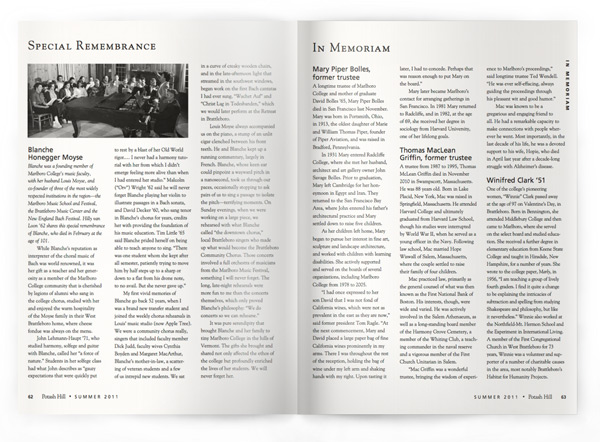
Special Remembrance: Blanche Honegger Moyse
Blanche was a founding member of Marlboro College’s music faculty, with her husband Louis Moyse, and co-founder of three of the most widely respected institutions in the region—the Marlboro Music School and Festival, the Brattleboro Music Center and the New England Bach Festival. Hilly van Loon ’62 shares this special remembrance of Blanche, who died in February at the age of 101.
While Blanche’s reputation as interpreter of the choral music of Bach was world renowned, it was her gift as a teacher and her generosity as a member of the Marlboro College community that is cherished by legions of alumni who sang in the college chorus, studied with her and enjoyed the warm hospitality of the Moyse family in their West Brattleboro home, where cheese fondue was always on the menu.
John Lehmann-Haupt ’71, who studied harmony, solfege and guitar with Blanche, called her “a force of nature.” Students in her solfege class had what John describes as “gauzy expectations that were quickly put to rest by a blast of her Old World rigor.… I never had a harmony tutorial with her from which I didn’t emerge feeling more alive than when I had entered her studio.” Malcolm (“Orv”) Wright ’62 said he will never forget Blanche playing her violin to illustrate passages in a Bach sonata, and David Decker ’60, who sang tenor in Blanche’s chorus for years, credits her with providing the foundation of his music education. Tim Little ’65 said Blanche prided herself on being able to teach anyone to sing. “There was one student whom she kept after all semester, patiently trying to move him by half steps up to a sharp or down to a flat from his drone note, to no avail. But she never gave up.
My first vivid memories of Blanche go back 52 years, when I was a brand new transfer student and joined the weekly chorus rehearsals in Louis’ music studio (now Apple Tree). We were a community chorus really, singers that included faculty member Dick Judd, faculty wives Cynthia Boyden and Margaret MacArthur, Blanche’s mother-in-law, a scattering of veteran students and a few of us intrepid new students. We sat in a curve of creaky wooden chairs, and in the late-afternoon light that streamed in the southwest windows, began work on the first Bach cantatas I had ever sung, “Wachet Auf” and “Christ Lag in Todesbanden,” which we would later perform at the Retreat in Brattleboro.
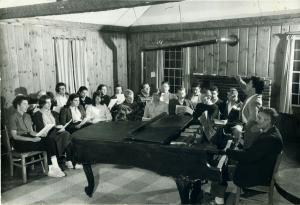 Louis Moyse always accompanied us on the piano, a stump of an unlit cigar clenched between his front teeth. He and Blanche kept up a running commentary, largely in French. Blanche, whose keen ear could pinpoint a wayward pitch in a nanosecond, took us through our paces, occasionally stopping to ask pairs of us to sing a passage to isolate the pitch—terrifying moments. On Sunday evenings, when we were working on a large piece, we rehearsed with what Blanche called “the downtown chorus,” local Brattleboro singers who made up what would become the Brattleboro Community Chorus. Those concerts involved a full orchestra of musicians from the Marlboro Music Festival, something I will never forget. The long, late-night rehearsals were more fun to me than the concerts themselves, which only proved Blanche’s philosophy: “We do concerts so we can rehearse.”
Louis Moyse always accompanied us on the piano, a stump of an unlit cigar clenched between his front teeth. He and Blanche kept up a running commentary, largely in French. Blanche, whose keen ear could pinpoint a wayward pitch in a nanosecond, took us through our paces, occasionally stopping to ask pairs of us to sing a passage to isolate the pitch—terrifying moments. On Sunday evenings, when we were working on a large piece, we rehearsed with what Blanche called “the downtown chorus,” local Brattleboro singers who made up what would become the Brattleboro Community Chorus. Those concerts involved a full orchestra of musicians from the Marlboro Music Festival, something I will never forget. The long, late-night rehearsals were more fun to me than the concerts themselves, which only proved Blanche’s philosophy: “We do concerts so we can rehearse.”
It was pure serendipity that brought Blanche and her family to tiny Marlboro College in the hills of Vermont. The gifts she brought and shared not only affected the ethos of the college but profoundly enriched the lives of her students. We will never forget her.
Mary Piper Bolles, former trustee
A longtime trustee of Marlboro College and mother of graduate David Bolles ’65, Mary Piper Bolles died in San Francisco last November. Mary was born in Portsmith, Ohio, in 1913, the oldest daughter of Marie and William Thomas Piper, founder of Piper Aviation, and was raised in Bradford, Pennsylvania.
In 1931 Mary entered Radcliffe College, where she met her husband, architect and art gallery owner John Savage Bolles. Prior to graduation, Mary left Cambridge for her honeymoon in Egypt and Iran. They returned to the San Francisco Bay Area, where John entered his father’s architectural practice and Mary settled down to raise five children.
As her children left home, Mary began to pursue her interest in fine art, sculpture and landscape architecture, and worked with children with learning disabilities. She actively supported and served on the boards of several organizations, including Marlboro College from 1978 to 2005.
“I had once expressed to her son David that I was not fond of California wines, which were not as prevalent in the east as they are now,” said former president Tom Ragle. “At the next commencement, Mary and David placed a large paper bag of fine California wines prominently in my arms. There I was throughout the rest of the reception, holding the bag of wine under my left arm and shaking hands with my right. Upon tasting it later, I had to concede. Perhaps that was reason enough to put Mary on the board.”
Mary later became Marlboro’s contact for arranging gatherings in San Francisco. In 1981 Mary returned to Radcliffe, and in 1982, at the age of 69, she received her degree in sociology from Harvard University, one of her lifelong goals.
Thomas MacLean Griffin, former trustee
A trustee from 1987 to 1995, Thomas McLean Griffin died in November 2010 in Swampscott, Massachusetts. He was 88 years old. Born in Lake Placid, New York, Mac was raised in Springfield, Massachusetts. He attended Harvard College and ultimately graduated from Harvard Law School, though his studies were interrupted by World War II, when he served as a young officer in the Navy. Following law school, Mac married Hope Wiswall of Salem, Massachusetts, where the couple settled to raise their family of four children.
Mac practiced law, primarily as the general counsel of what was then known as the First National Bank of Boston. His interests, though, were wide and varied. He was actively involved in the Salem Athenaeum, as well as a long-standing board member of the Harmony Grove Cemetery, a member of the Whiting Club, a teaching commander in the naval reserve and a vigorous member of the First Church Unitarian in Salem.
“Mac Griffin was a wonderful trustee, bringing the wisdom of experience to Marlboro’s proceedings,” said longtime trustee Ted Wendell. “He was ever self-effacing, always guiding the proceedings through his pleasant wit and good humor.”
Mac was known to be a gregarious and engaging friend to all. He had a remarkable capacity to make connections with people wherever he went. Most importantly, in the last decade of his life, he was a devoted support to his wife, Hopie, who died in April last year after a decade-long struggle with Alzheimer’s disease.
Winifred Clark ’51
One of the college’s pioneering women, “Winnie” Clark passed away at the age of 97 on Valentine’s Day, in Brattleboro. Born in Bennington, she attended Middlebury College and then came to Marlboro, where she served on the select board and studied education. She received a further degree in elementary education from Keene State College and taught in Hinsdale, New Hampshire, for a number of years. She wrote to the college paper, Marly, in 1956, “I am teaching a group of lively fourth graders. I find it quite a change to be explaining the intricacies of subtraction and spelling from studying Shakespeare and philosophy, but like it nevertheless.” Winnie also worked at the Northfield-Mt. Hermon School and the Experiment in International Living. A member of the First Congregational Church in West Brattleboro for 73 years, Winnie was a volunteer and supporter of a number of charitable causes in the area, most notably Brattleboro’s Habitat for Humanity Projects
William P. Toomey ’53
Bill Toomey died in April at the age of 81. He was born in North Adams, Massachusetts, and served on the Korean peninsula with the army’s 7th Infantry Division, which was charged with overseeing the Japanese surrender. In 1949 he enrolled at Marlboro on the G.I. Bill, graduating with a degree in sociology.
“He was always proud of having gone to Marlboro, and his experiences there influenced his whole life,” said Bill’s son Dan Toomey ’79. Bill worked for a short period as a carpenter in North Adams before beginning his teaching career in Readsboro, Vermont. Bill then earned a master’s degree in education from North Adams State College, teaching first at Brayton School and later for many years at Greylock Elementary School, as well as serving as assistant principal at both. An active athlete, he coached football and baseball and was an early member of the ski patrol at Dutch Hill in Heartwellville, Vermont.
Josiah (J.K.) Adams ’67
Josiah Adams died in April, at the end of a brave battle with cancer. J.K. was born in San Francisco, but after World War II his family moved to the East Coast, where he and his siblings were raised. He was a skilled pianist and organist, and involved in choral singing, pursuing these interests while at Marlboro College. In later years he also became an accomplished graphic artist, but he discovered that teaching gave fullest expression to his talents. He taught for eight years at St. John’s Episcopal School in Puerto Cortes, Honduras, and then for many years at the Elan School in Poland Spring, Maine. Among the courses he taught were physics, chemistry, organic chemistry, astronomy, history of music and philosophy, and he played important roles in designing the curriculum and in college advising. He taught with intense discipline, organization, enthusiasm and deep knowledge. J.K. was the father of Marlboro alumna Oona Adams ’94.
Thomas V. Durgin ’79
Tom Durgin died unexpectedly in March at his home in Thetford, Vermont. He was 57. A native of Maine, Tom studied biology, forestry, photography and psychology at Marlboro, completing his Plan on the symptoms and etiology of autism. Outside of his academic pursuits, Tom was known for helping design the infamous “road rallies” that were part of Fall and Spring Rites in the late 1970s. Directly following college, Tom worked with autistic children and for the educational software division of Houghton Mifflin. He then went on to a varied career in writing, editing and publishing for Human Capital Institute, working on journals such as Behind the Times, It’s Classified and Cheap Skiing Guide, and for SnoCountry.org. Tom was an avid outdoorsman and enjoyed hiking, skiing, kayaking and sailing on the Maine coast. He was also interested in history, gardening, food and collecting treasures.
Jeanne Risica ’83
Jeanne Risica died on December 31, 2010, in Brooklyn, New York, where she had made her home for a number of years. Raised in Rhode Island, Jeanne came to Marlboro to study art, and completed a Plan in painting and Italian, studying with Frank Stout at Casa Campardi in Italy, where the college ran a program. Following Marlboro, Jeanne studied at the Art Students League in New York and spent the rest of her life as an artist. Her paintings were exhibited widely, from South Korea, Venezuela, Brussels and Italy to the northeast United States, frequently and most recently at the Dillon Gallery in New York City. Jeanne was also instrumental in tending the Red Gate Community Garden in Brooklyn, a task she was dedicated to for the past 10 years and that earned her the moniker “mother of the garden.”
Marcus Israel, former student
We received word that Marcus Israel died on July 3, 2010, in New York. A musician and “free spirit,” Marcus attended Marlboro with the class of ’93.
Philipp Naegele
Longtime college neighbor and participant in the Marlboro Music School and Festival, violist Philipp Naegele died in January at the age of 83. Philipp first came to Marlboro in 1950, when he was invited to play chamber music with violinist Adolf Busch, flutist Marcel Moyse and pianist Rudolf Serkin in the formative first year of the festival.
He also played for the Cleveland Orchestra, under the distinguished leadership of Georg Szell, before joining the faculty of Smith College in 1964. Before his retirement from Smith in 2000, Philipp regularly performed with such ensembles as Music From Marlboro, the Cantilena Piano Quartet and the Vegh String Quartet.
Parting Shot
